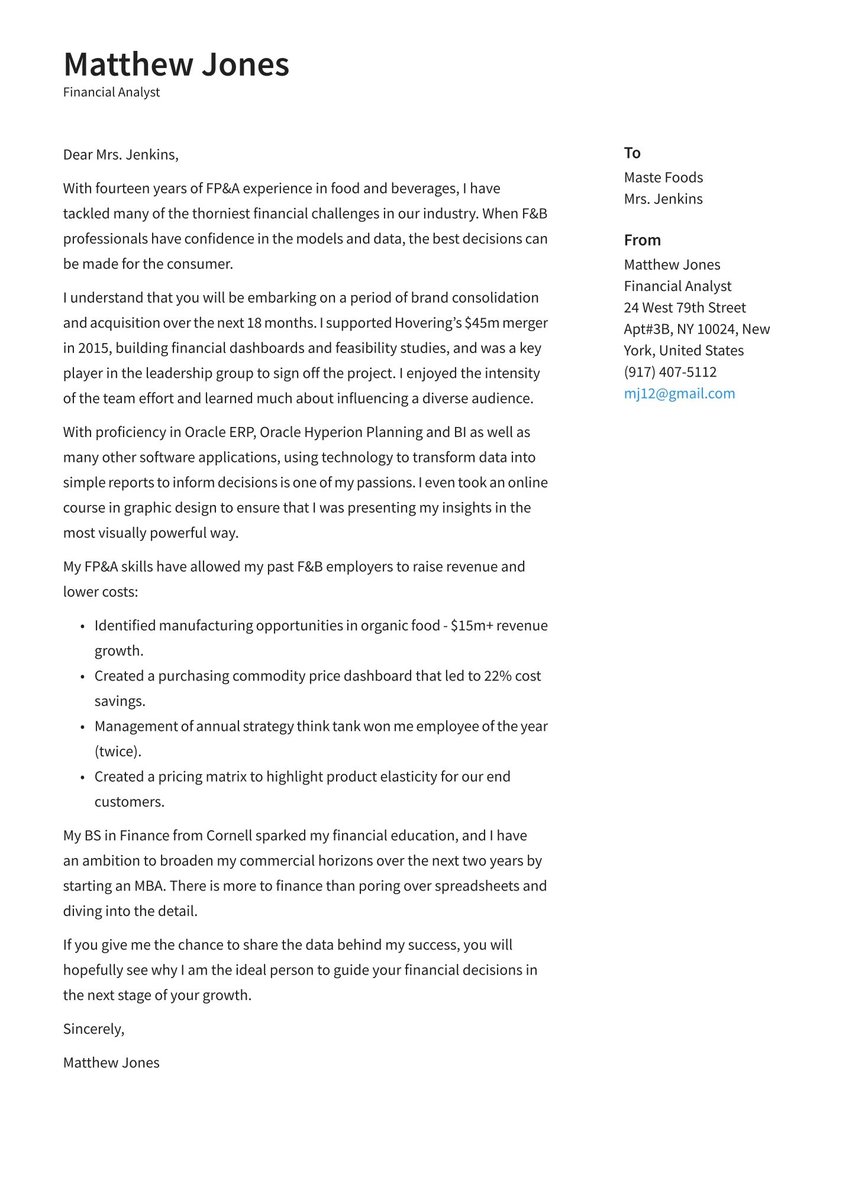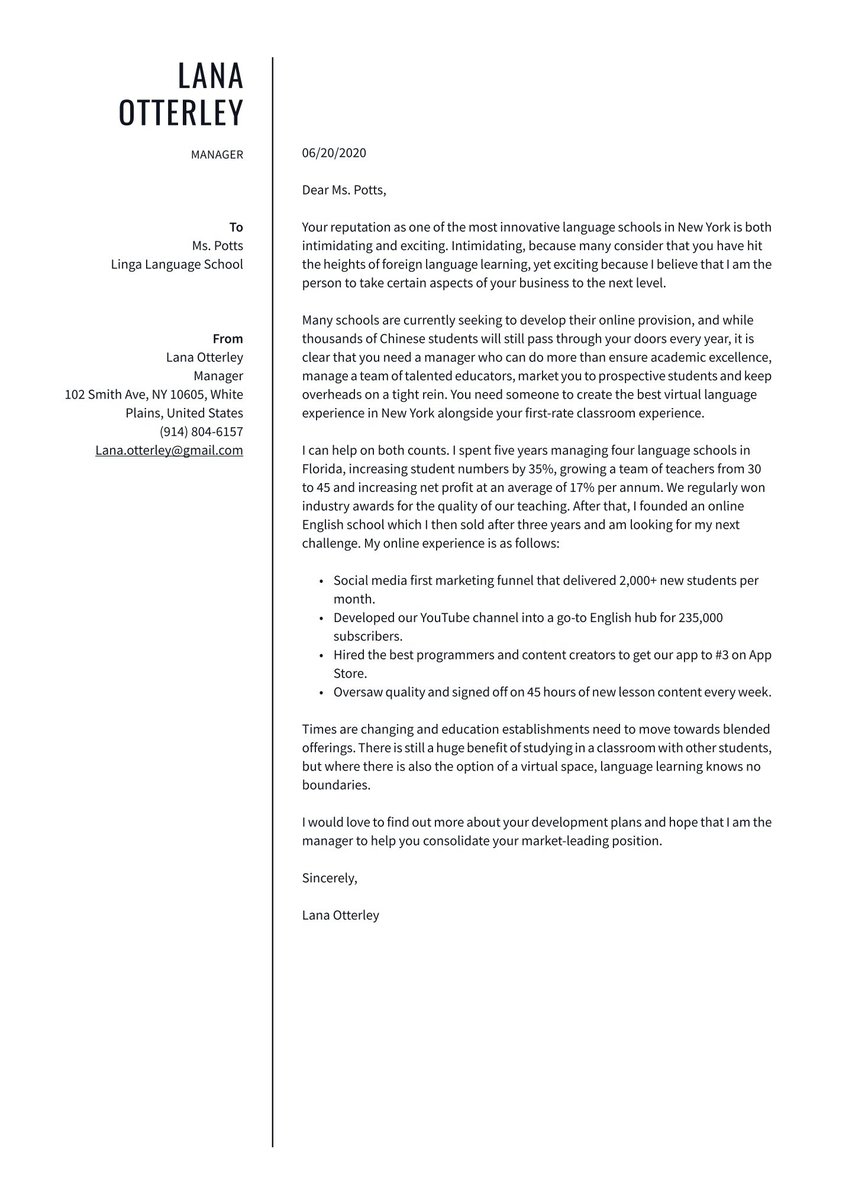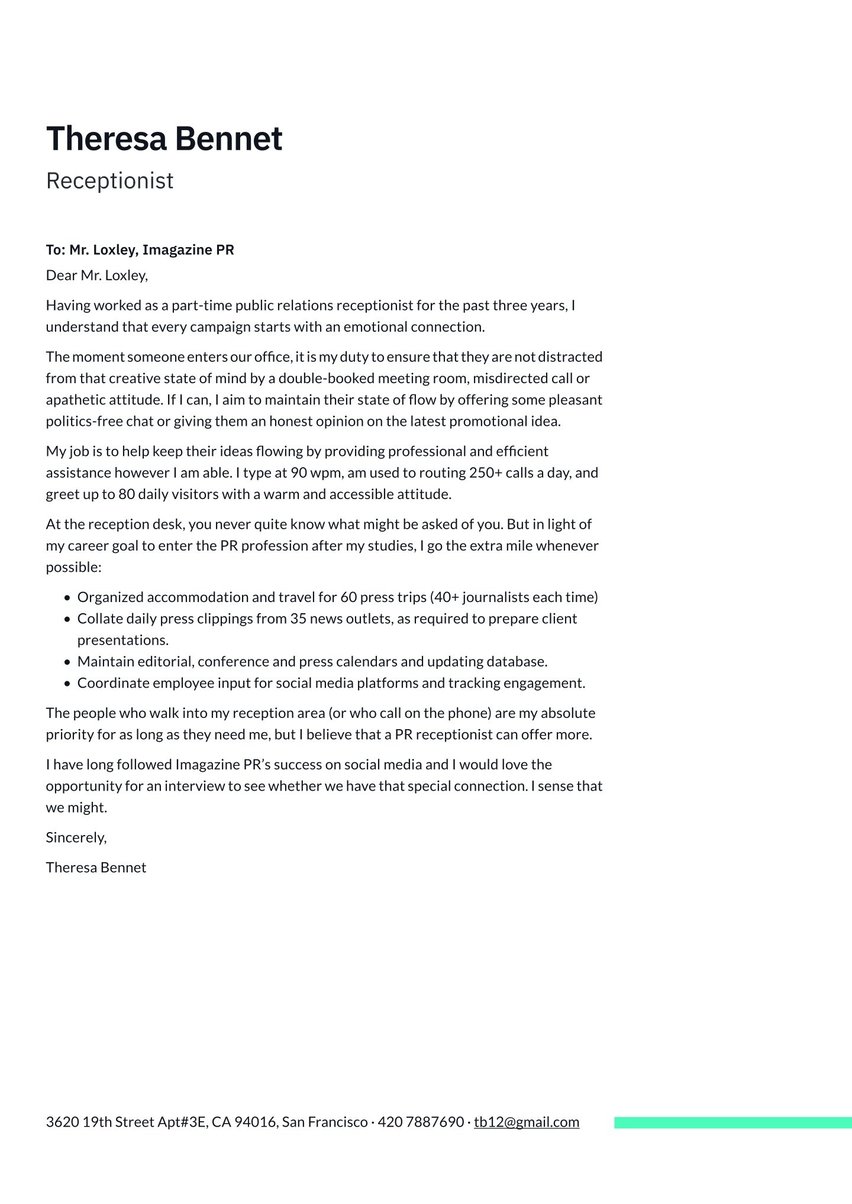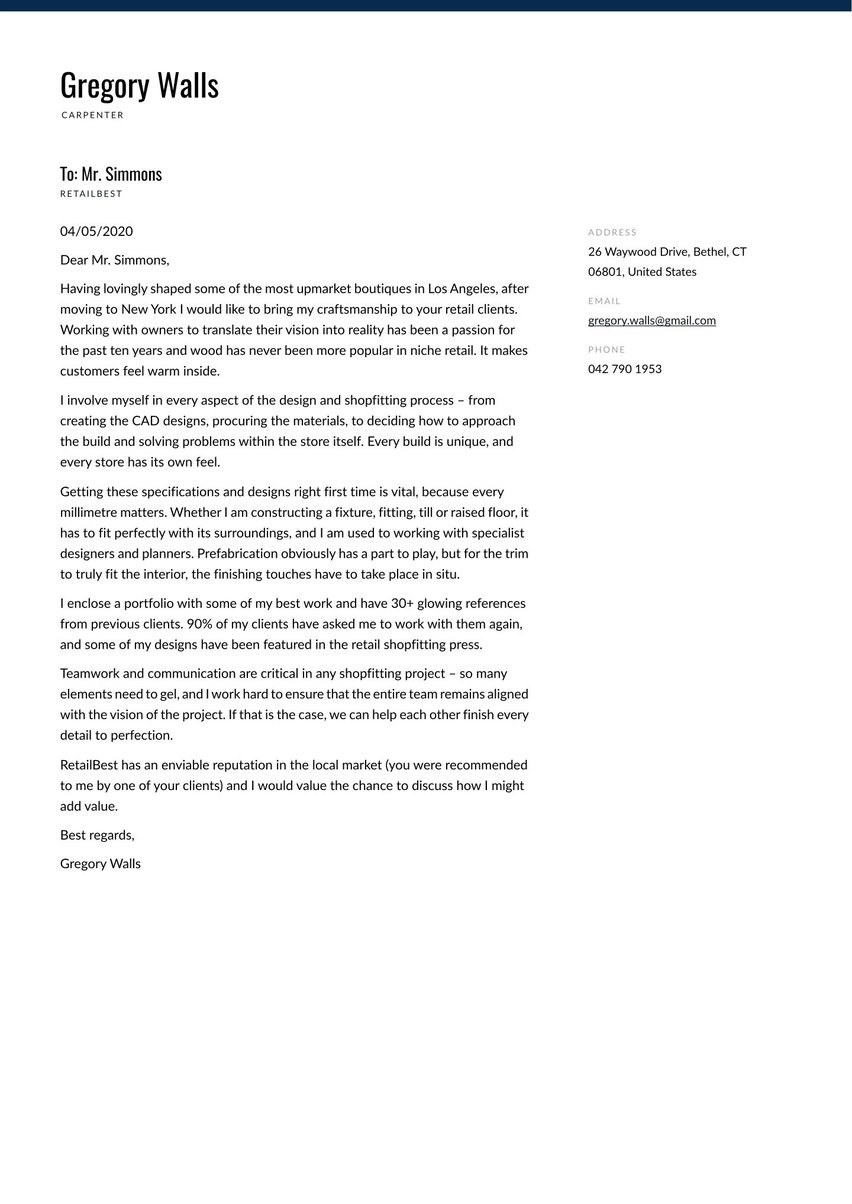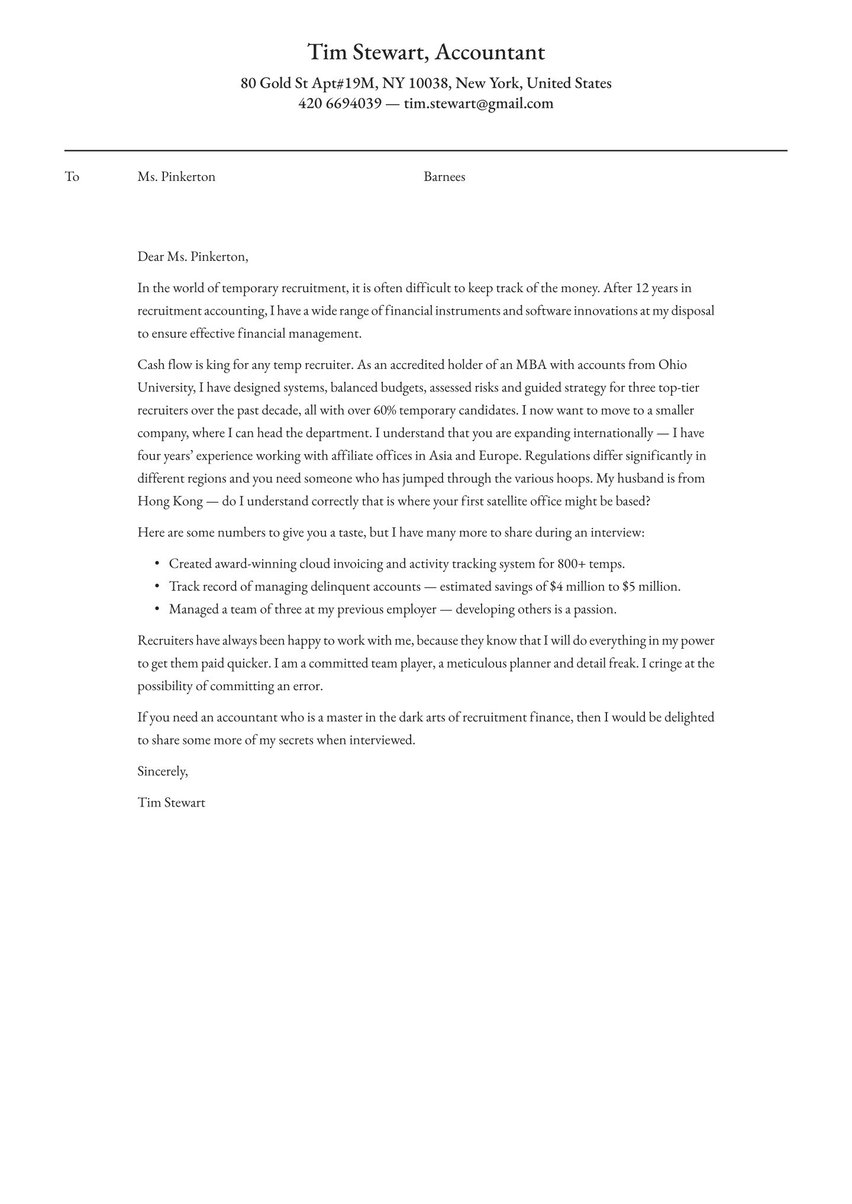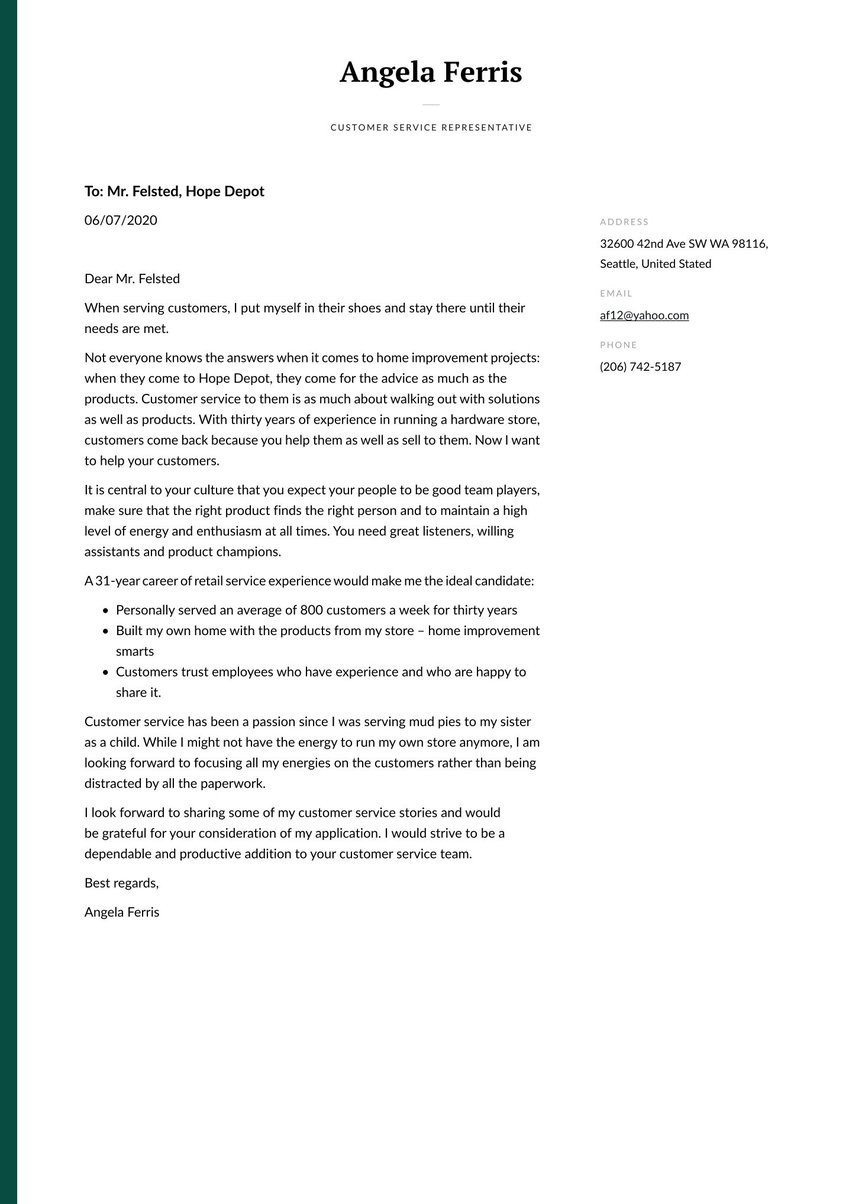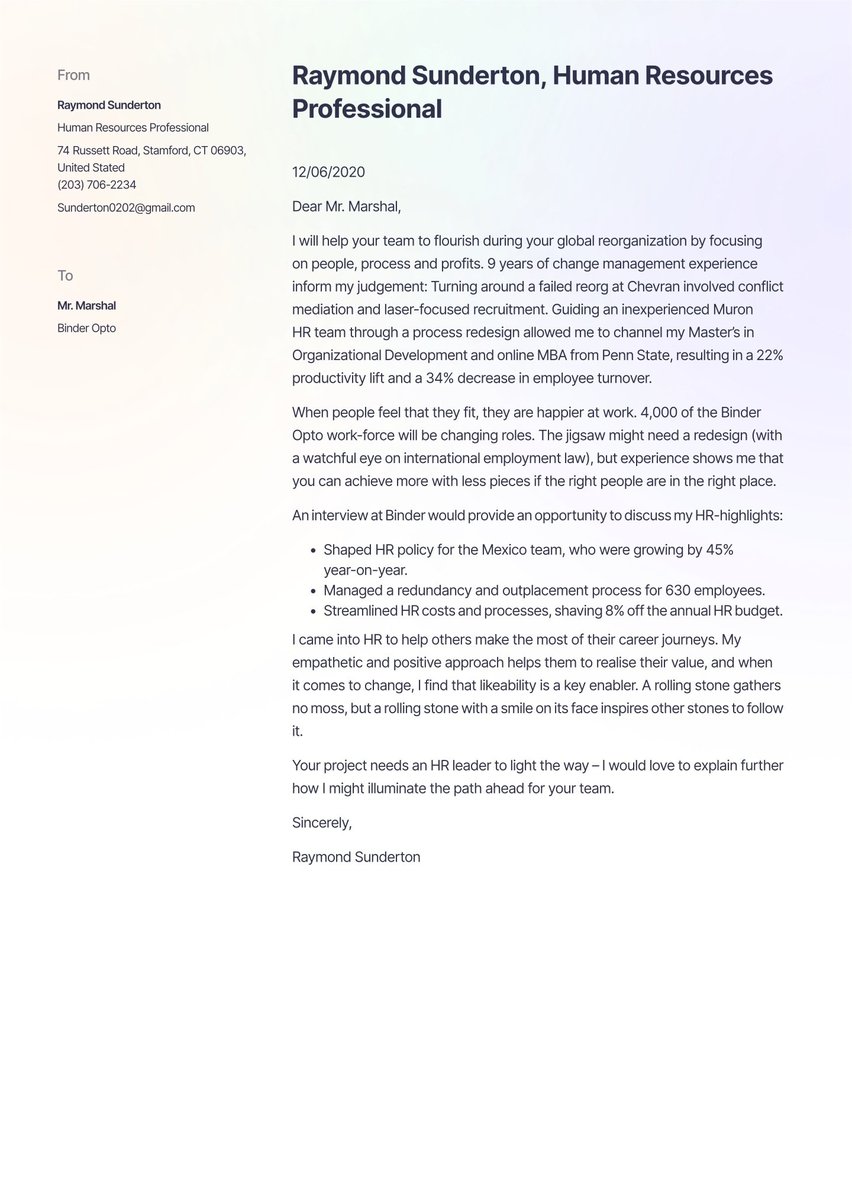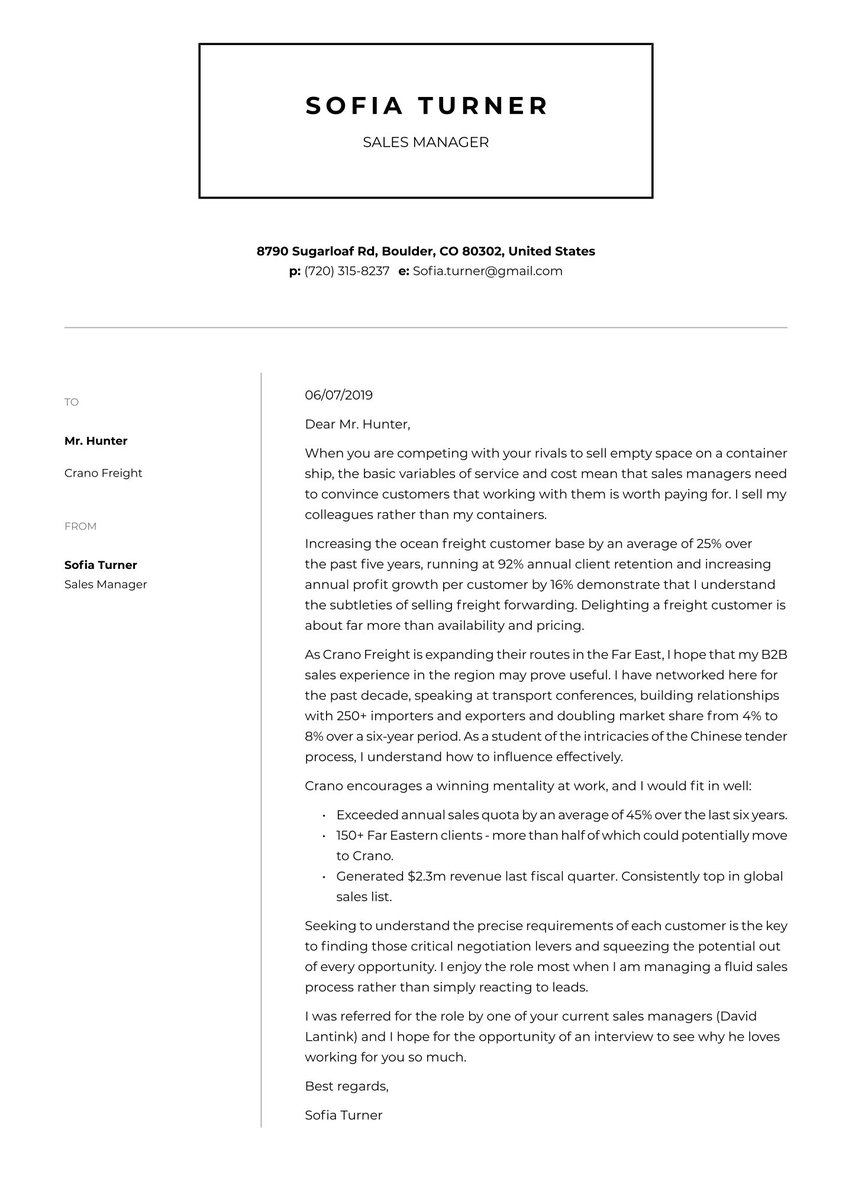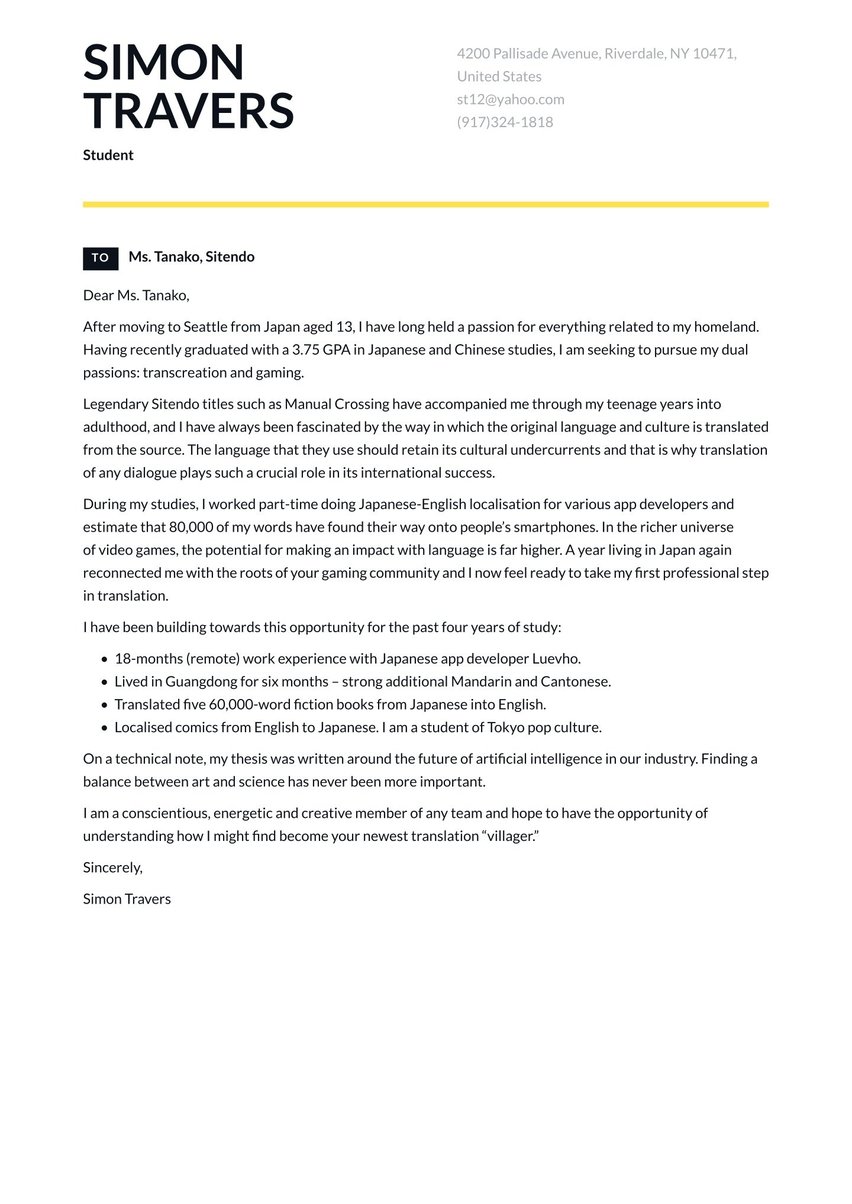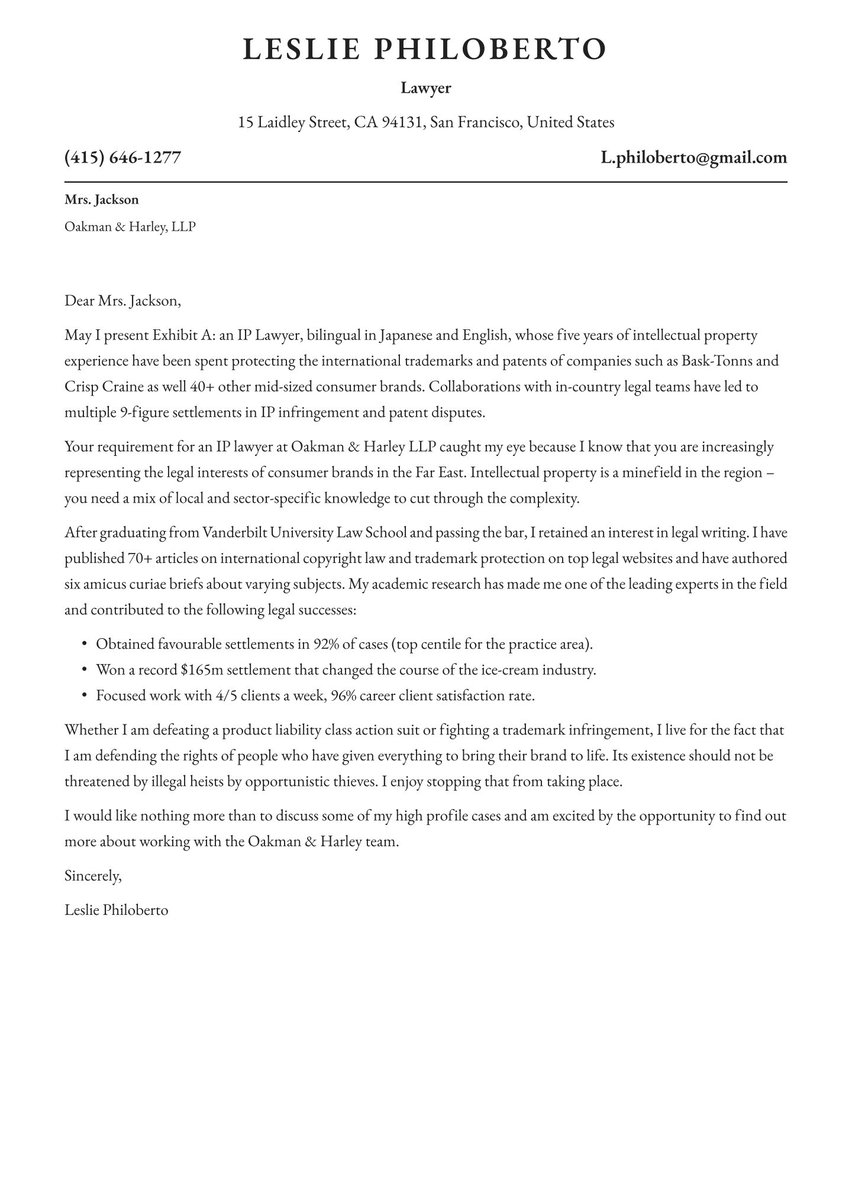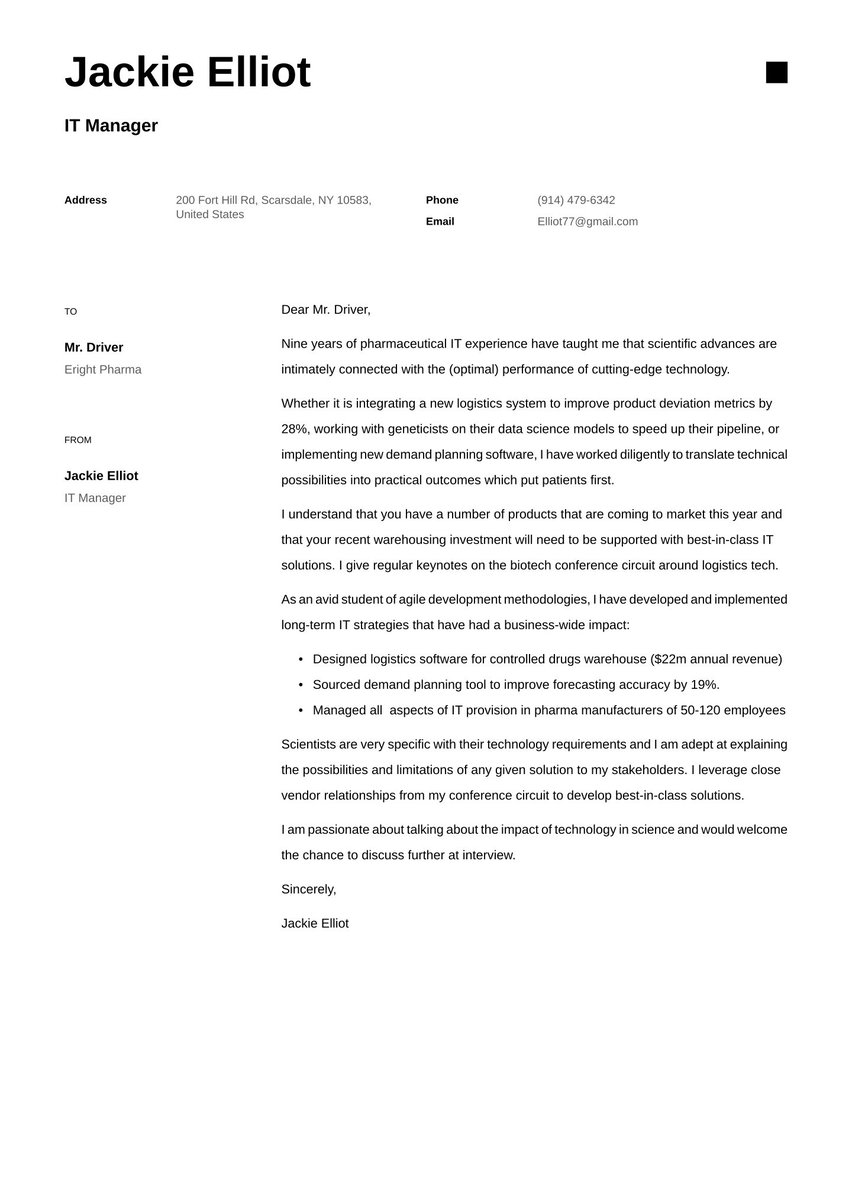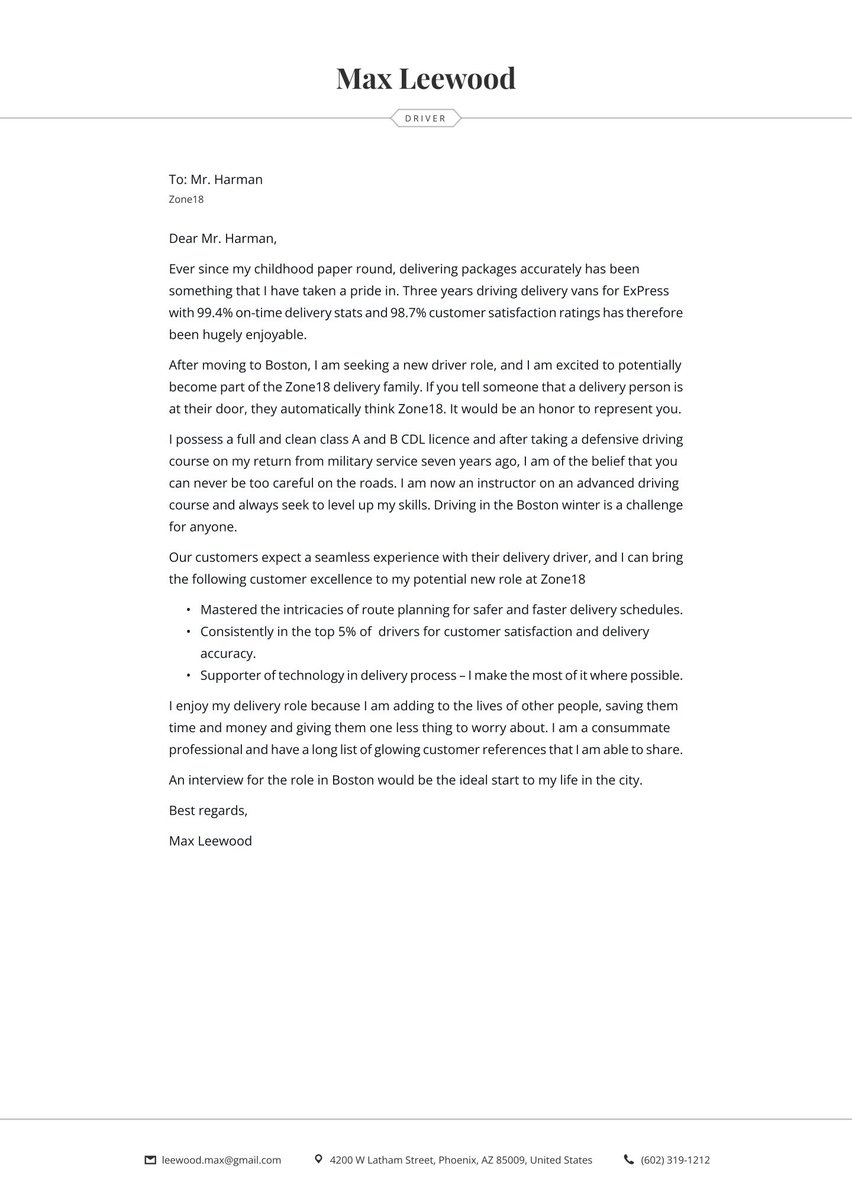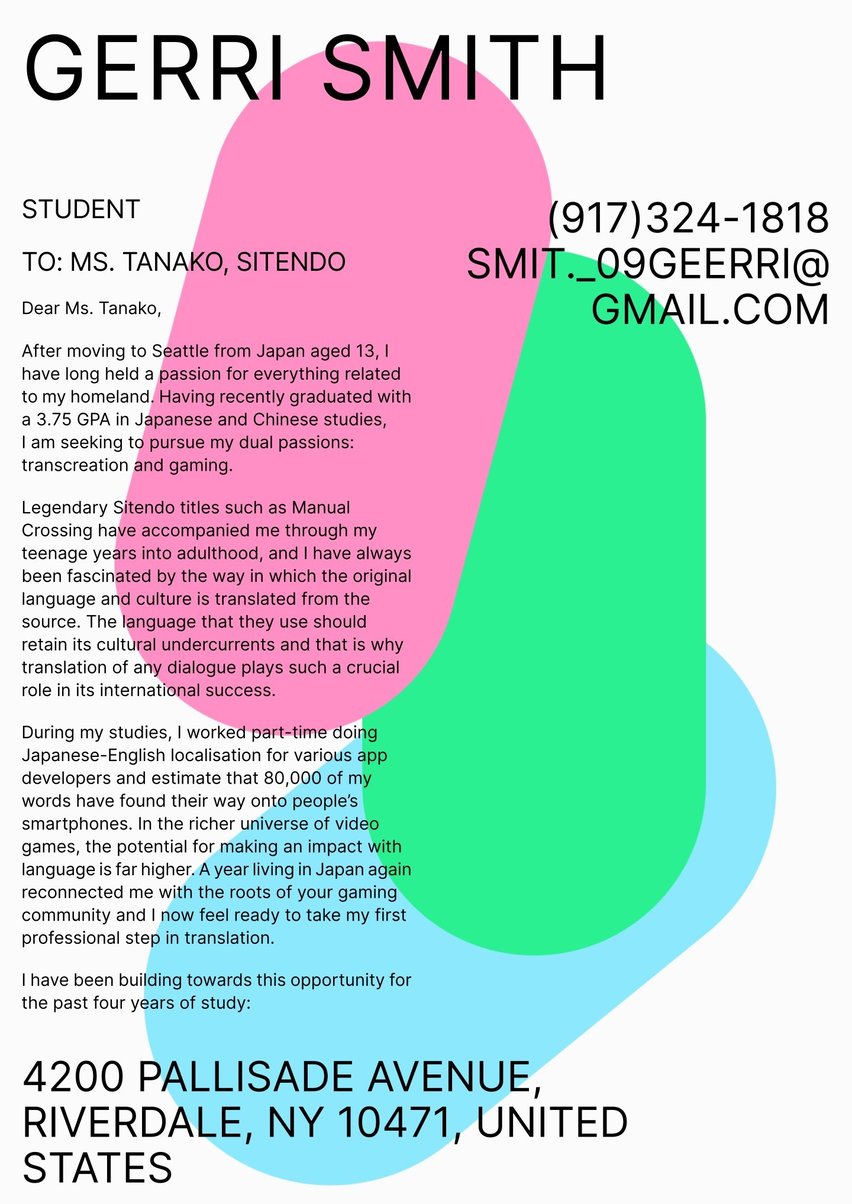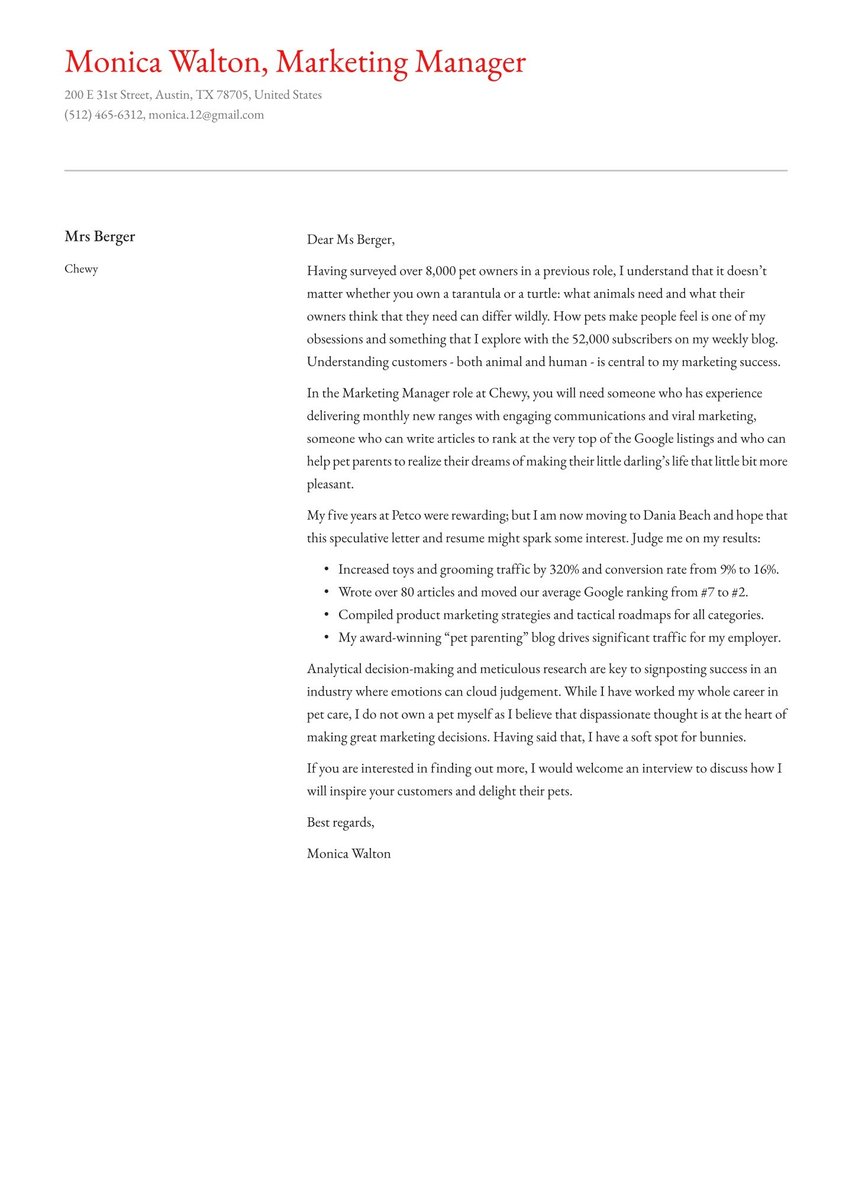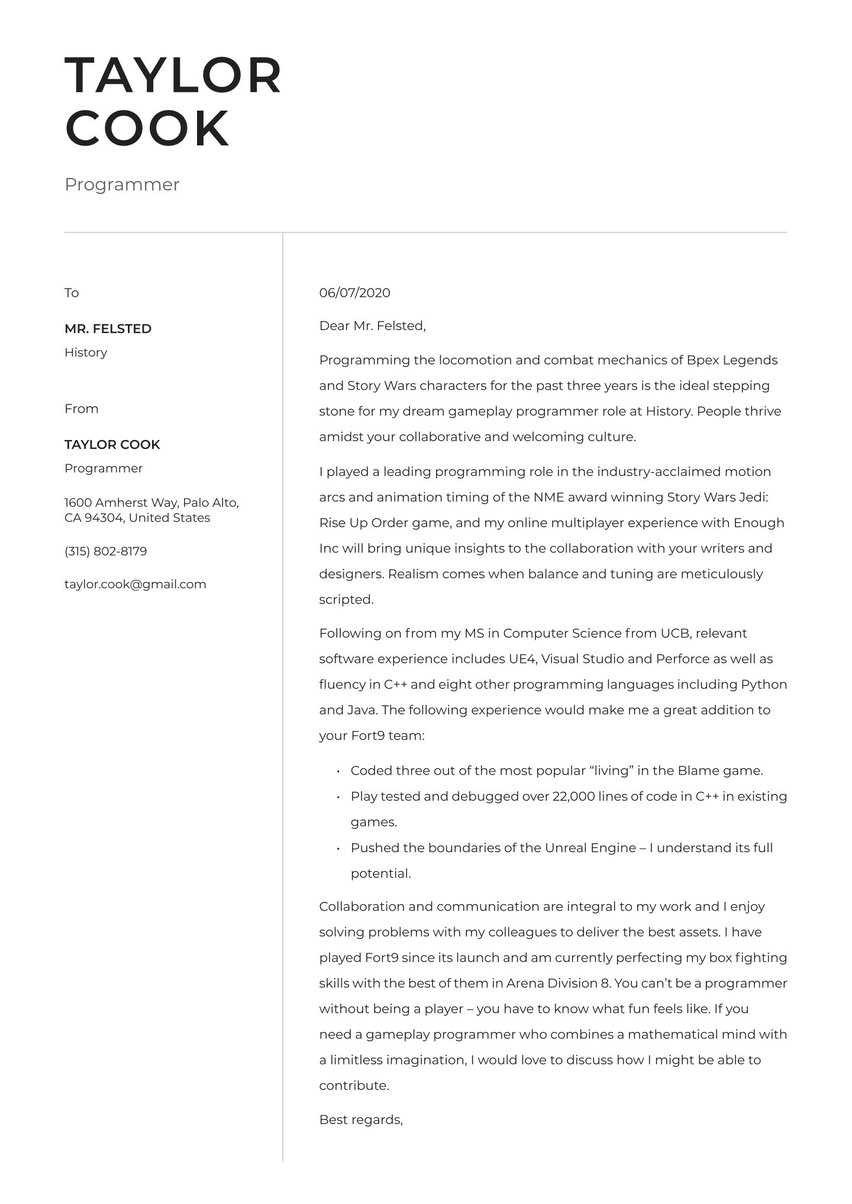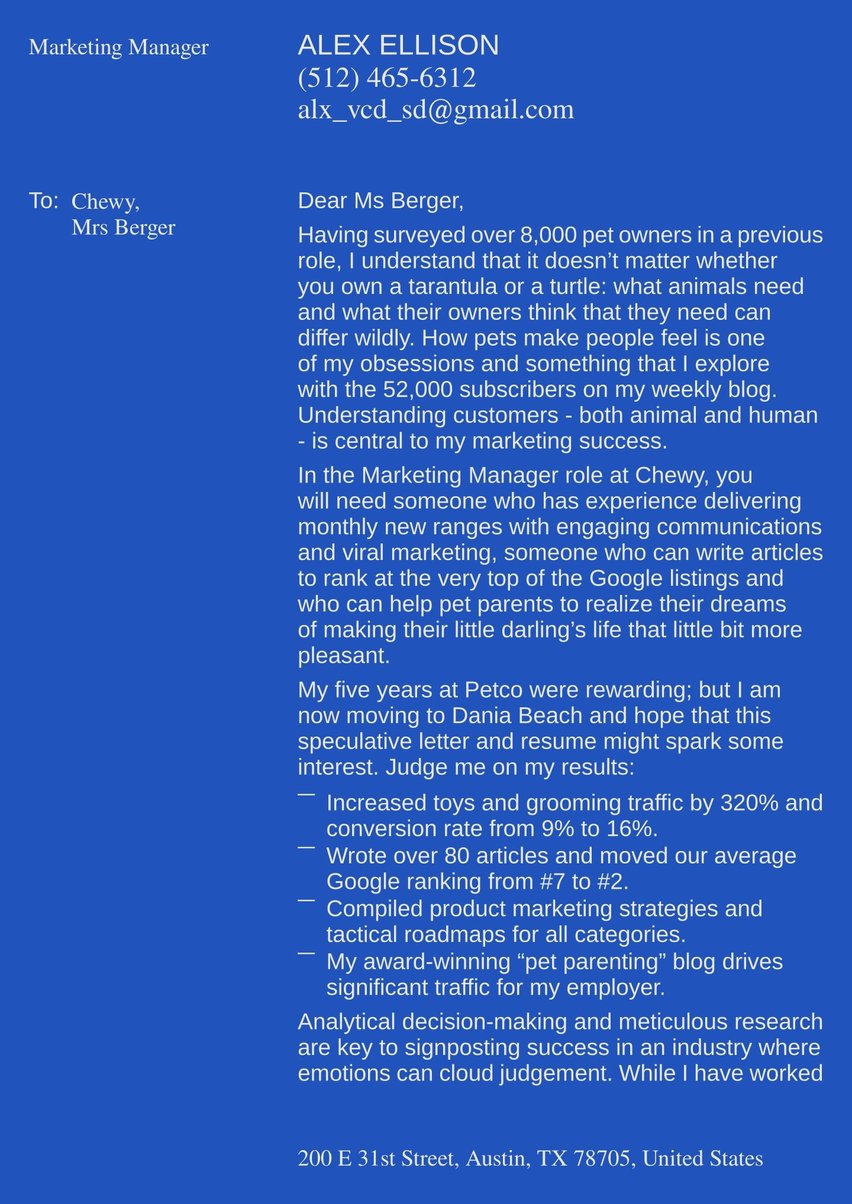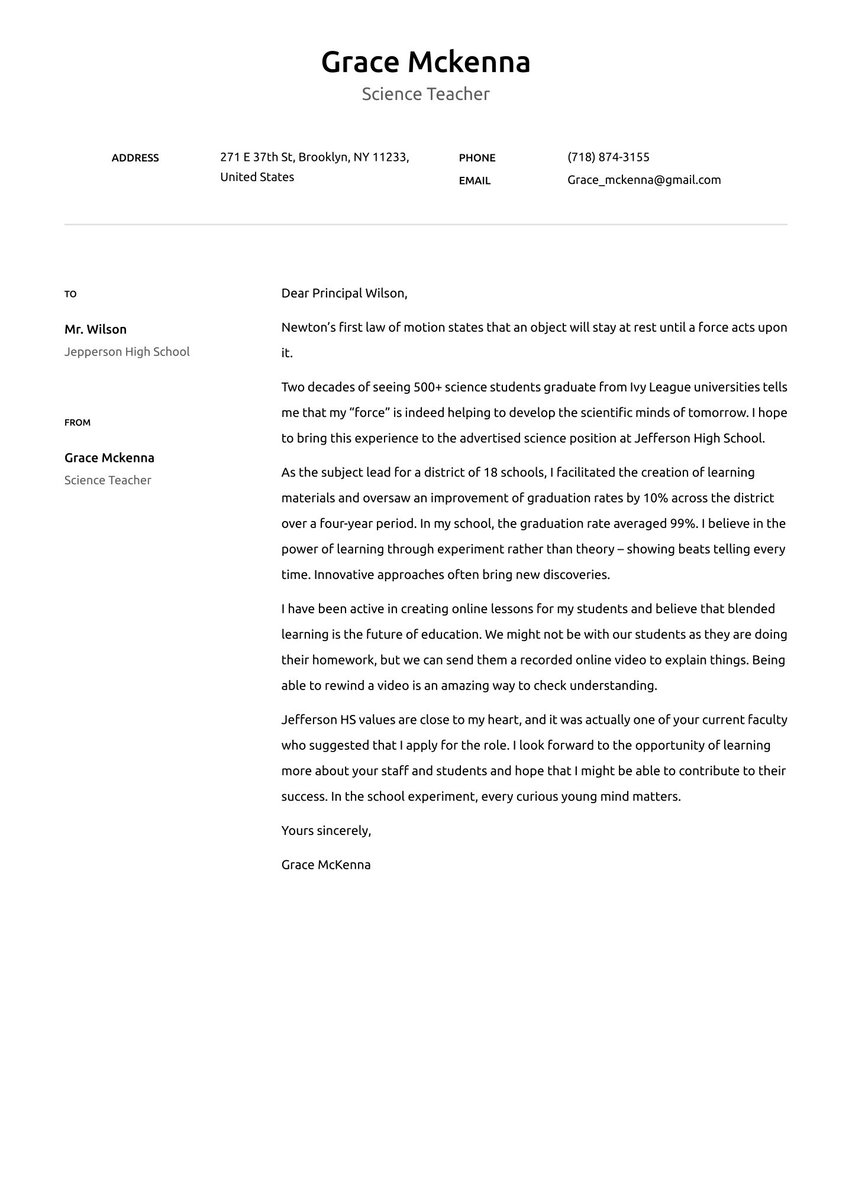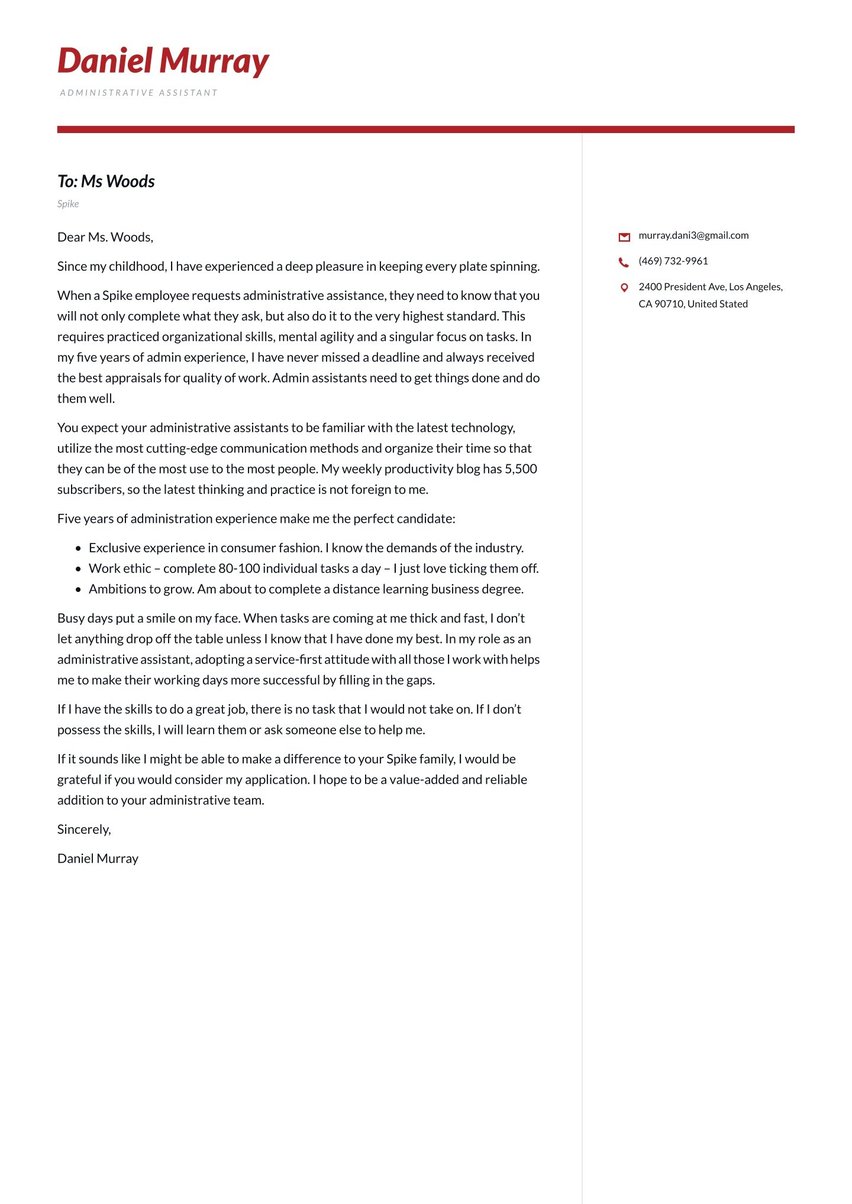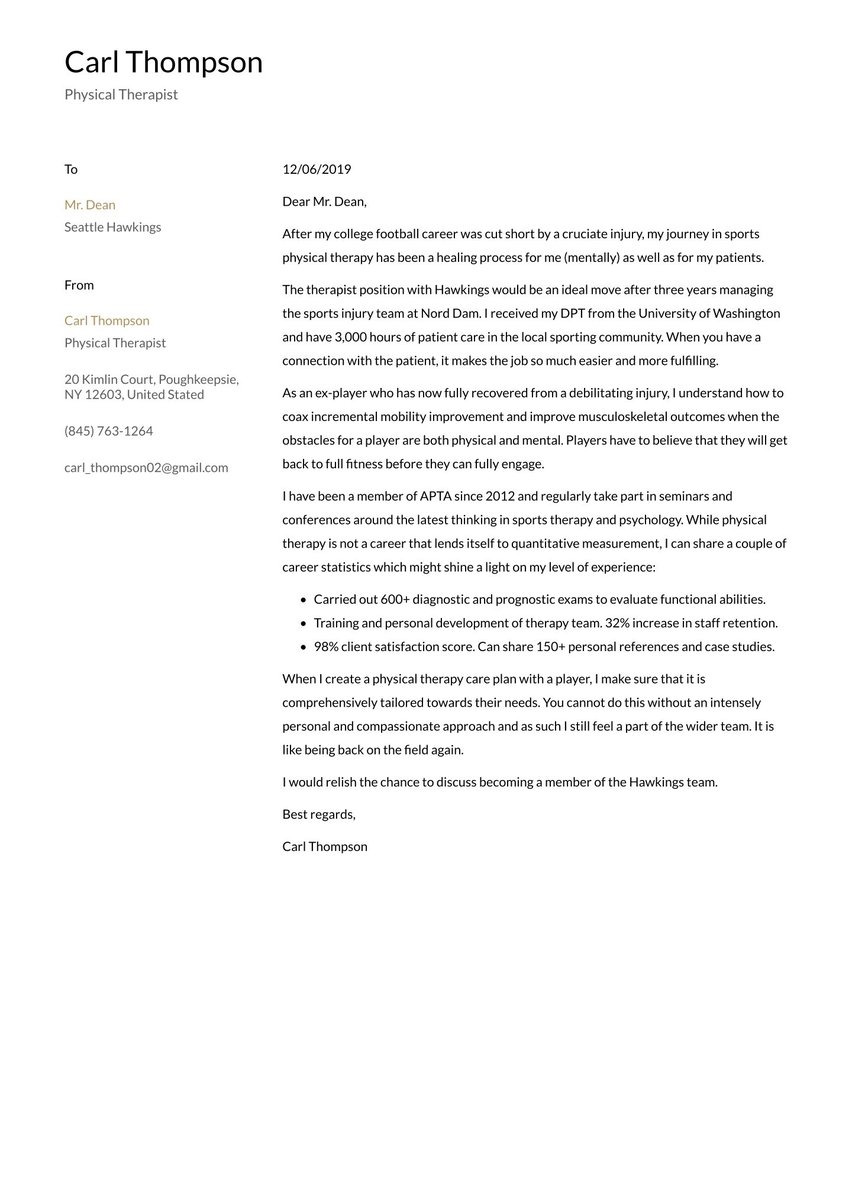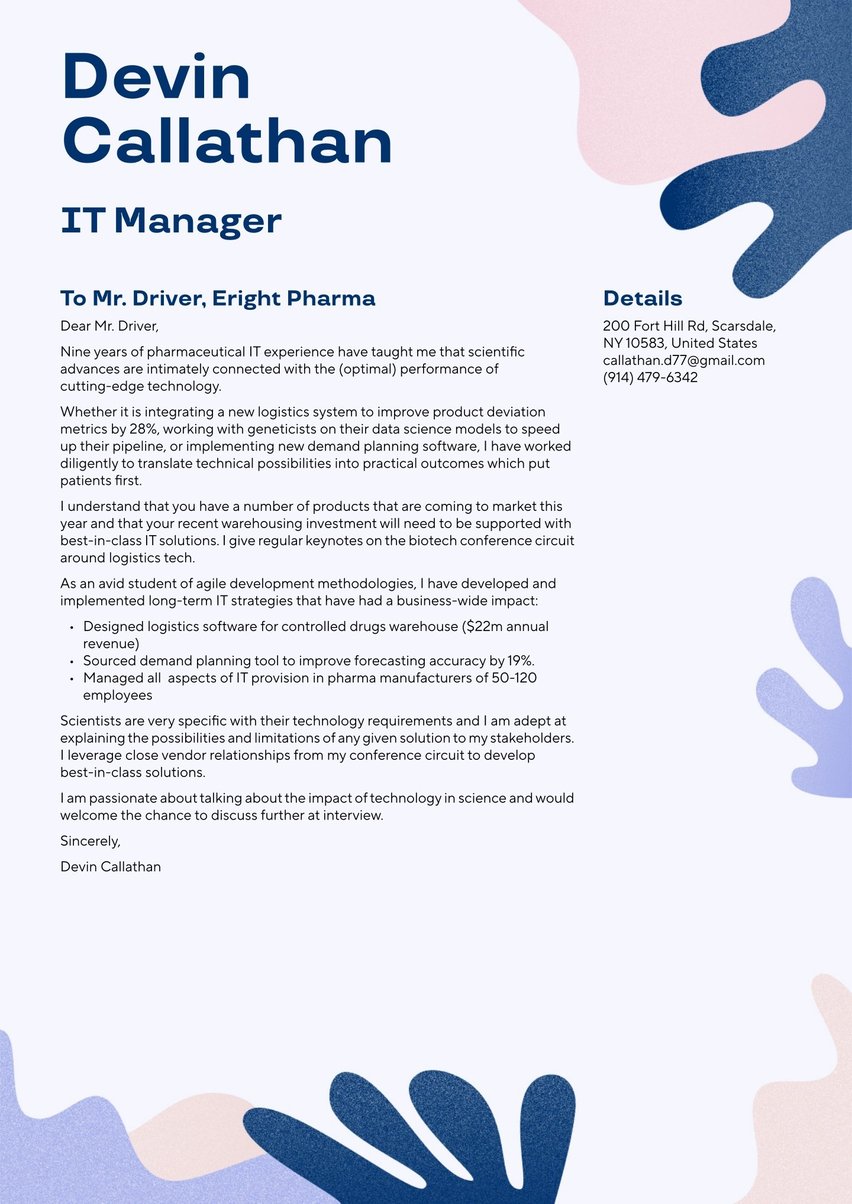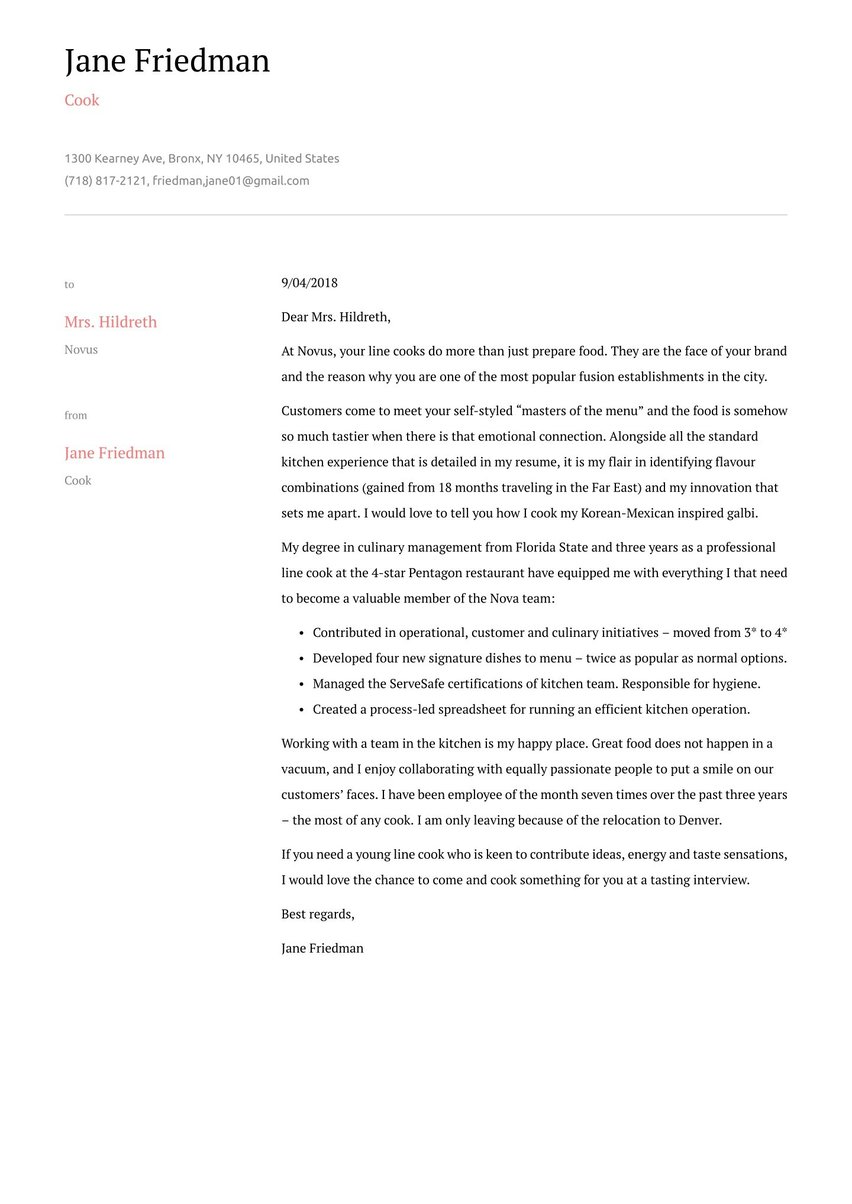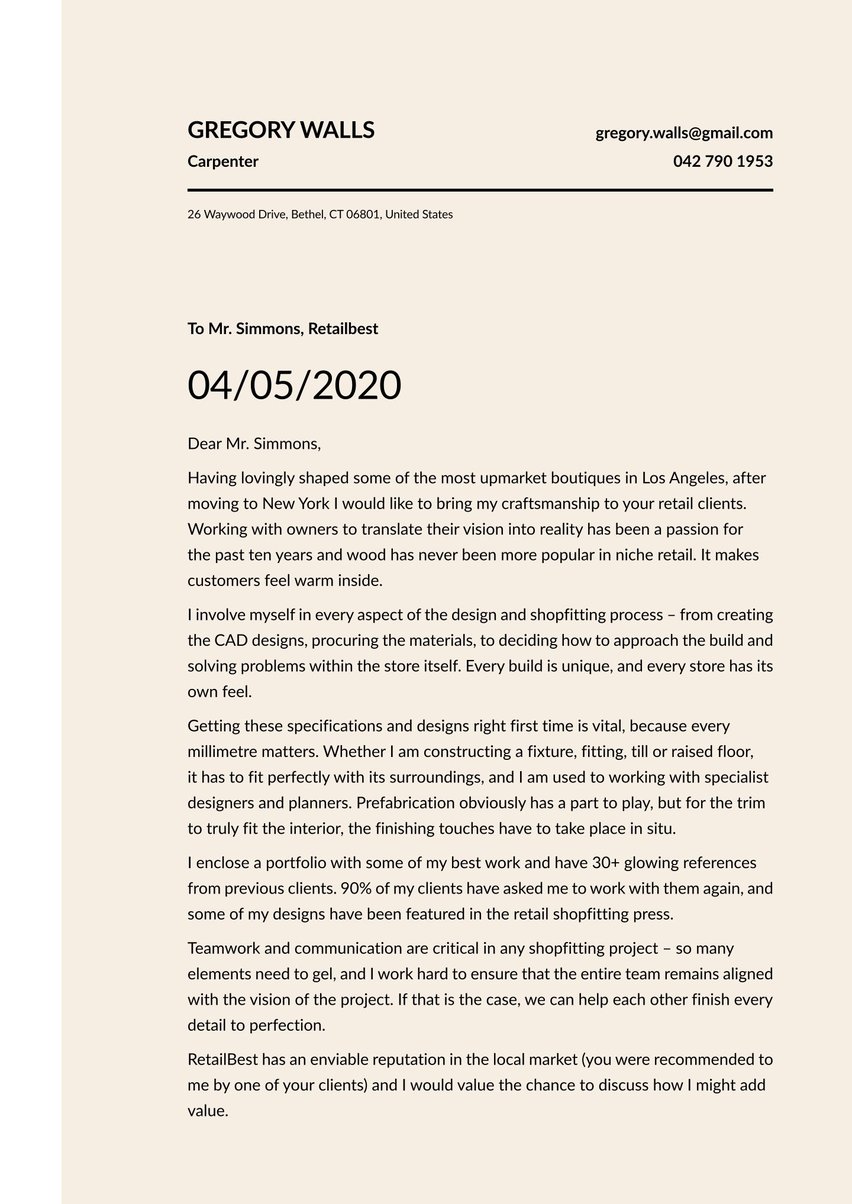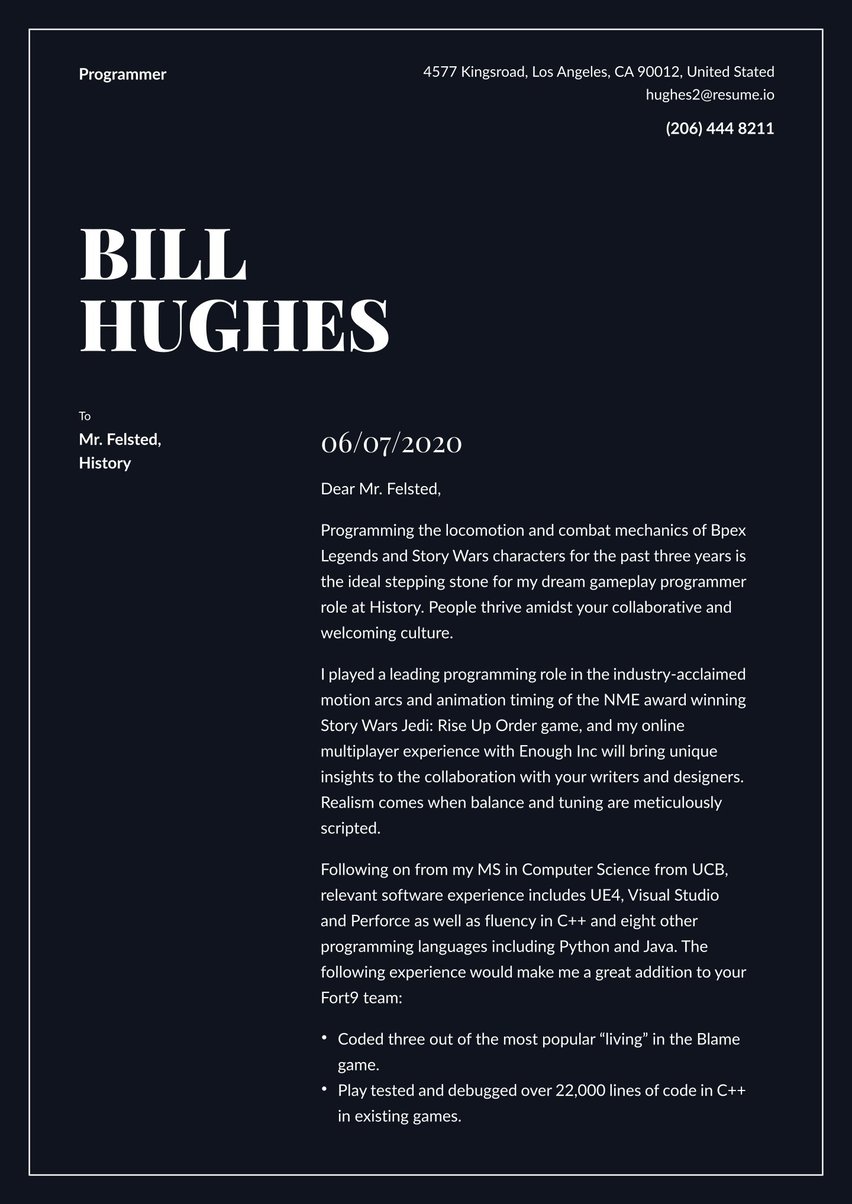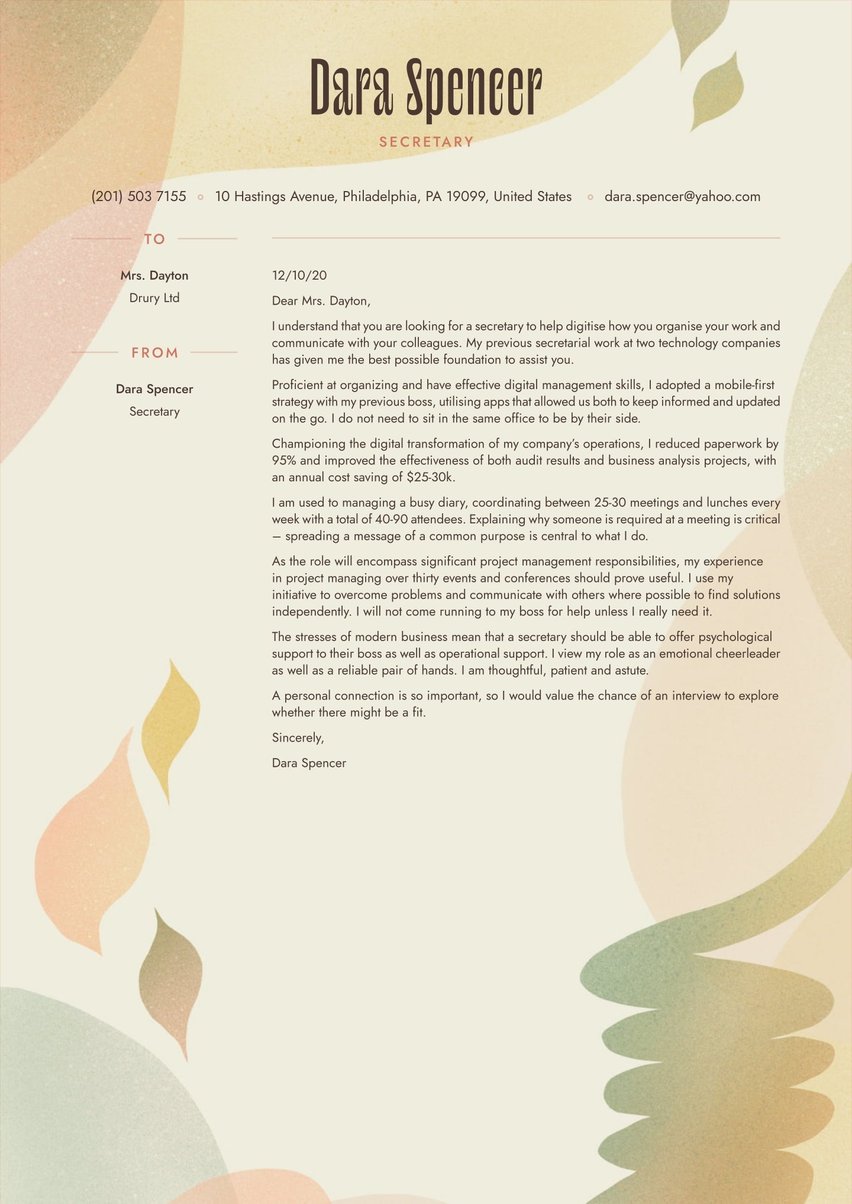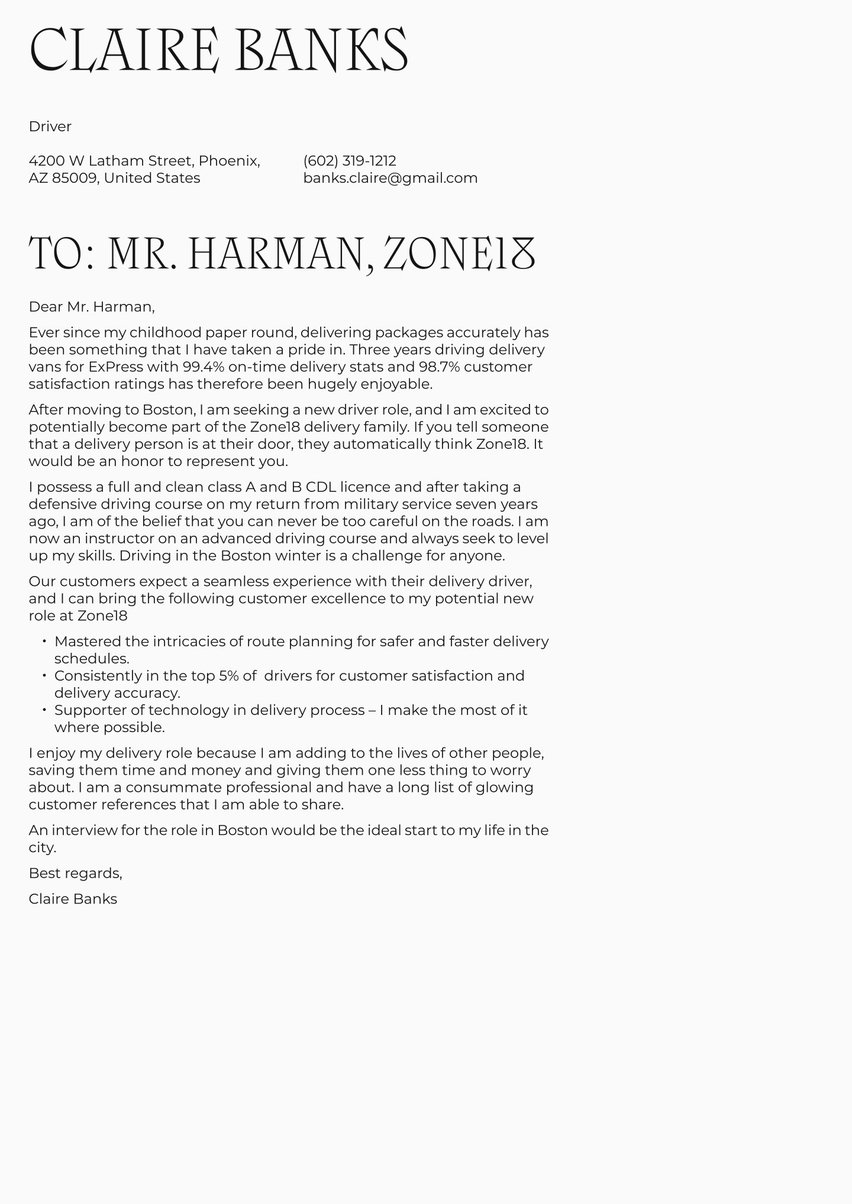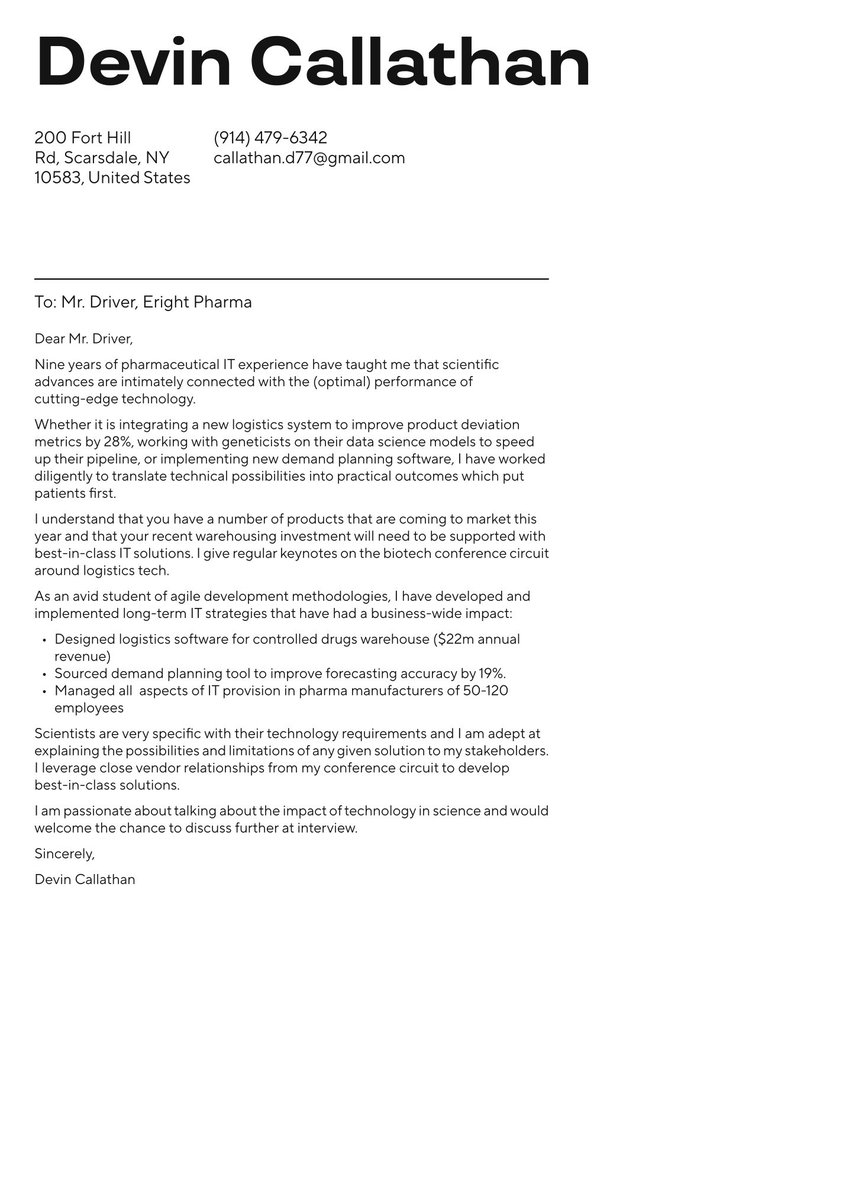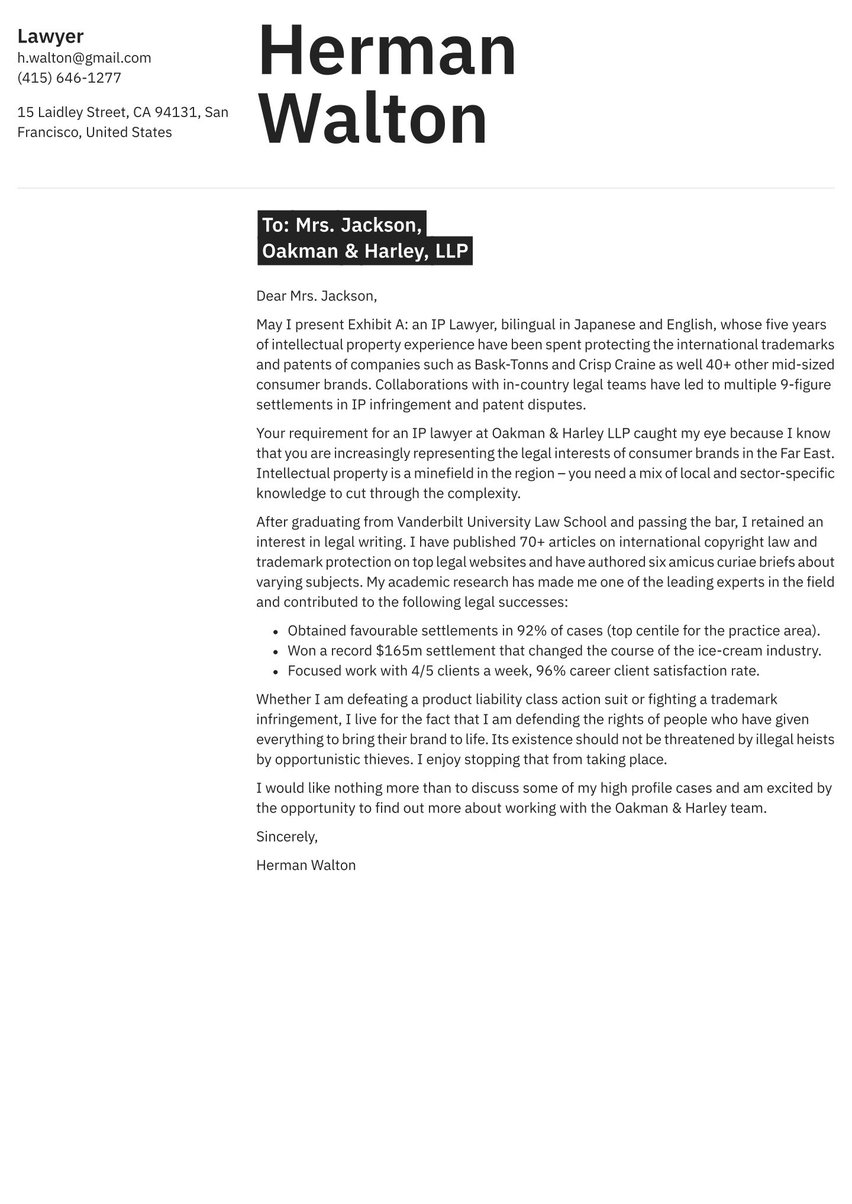Administration positions are some of the best opportunities to get inside in the door of your dream company. These positions offer plenty of room for growth and an inside look at both the world of administration and the industry in which you work.
Because these jobs make for great entry-level positions and require a generalized relevant skill set, they can be highly competitive. Making yourself stand out from other applicants should be one of the primary goals while creating your application.
To show off your unique advantages and enthusiasm for the position, you’ll need more than an exceptional resume. A great cover letter can truly make the difference when it comes to catching a hiring manager’s attention. Luckily with Resume.io’s collection of trusted tools and templates, writing the perfect cover letter is easier than you think.
This guide, along with our administration / assistant cover letter example will:
- Explain the proven advantage of a cover letter and its goals for your job search
- Break down the cover letter format, elements and provide free examples, samples and templates
- Detail the power of writing to persuade with tips to make your application stand out
- Help you avoid common mistakes and impress any employer with your unique skills
But first, if you haven’t already perfected your resume, that’s a great place to start. Check out our administration-specific examples, templates and general resume writing guide). Now it’s time to write the cover letter that seals the deal on your dream job.
Why write an administration cover letter?
Primary purpose
Before we dive into the importance of including a cover letter with your application, let’s take a look at what a cover letter actually is and what it accomplishes for you.
This one-page document (roughly 200 to 400 words) is much more free-form than your resume, meaning there’s plenty of space for you to elaborate on your most important achievements and strongest relevant skills.
While you probably had to keep your resume concise, your cover letter allows you to speak in your own tone of voice and to establish a personal connection with the hiring manager.
The writing is only half the battle, however. To truly make a great impression, you’ll need to use professional formatting as well. Sans serif fonts like Arial, Georgia and Helvetica with a size of about 11 points generally offer the best combination of style and readability. For even more specific formatting tips, check out our overall guide on cover letters.
What if the administration job application DOESN’T require a cover letter?
Sometimes a job application won’t mention if a cover letter is actually required. While this might seem like a free pass to save yourself the trouble, not including a cover letter could actually lower your chances of getting the job. Remember that competition in the modern job market is fierce, especially if you don’t want a mediocre job that will soon become a burden, but rather a good position to build a career from.
Unless specifically asked NOT to, it’s always a good idea to write and submit this document to highlight your strengths and maximize your chances of landing the position (more on that in a second!)
Secondary purpose
If you’ve already worked in administration, then you understand the importance of a great first impression. Whether you work in business administration, as an executive assistant or in another assistant position, you know that your communication skills are a big part of setting a professional tone for the workplace.
Likewise, the way you communicate in your cover letter sets the tone for how your entire application will be received. Some applicants overlook this document, thinking that a resume will be enough to land them the position.
But a great cover letter is your secret weapon. It allows you to maximize the chances that your application will stand out, even against candidates with years of experience in the field.
While your resume is designed to convey dates and names, it lacks space for you to convey personality – an important trait that allows you to fit in with the company culture. A cover letter is the perfect place to show off what makes you unique and answer any questions that may arise from your resume, like gaps in work history and work experience.
The importance of tailoring your cover letter
Writing a cover letter is a great start – but there’s one more step you’ll need to complete to make sure your cover letter is as effective as possible. Your document should include the most relevant skills, achievements and experiences for each individual position you apply for. Remember the golden rule that we also emphasize in many of our resume guides - TAILOR every document for EVERY specific job application. Sending out a one-size-fits-all resume or cover letter is a sure way to lose the competitive job race.
The job description and company website can help you get a feel for the office environment and the most important aspects of the job. The small time investment to adapt each letter can pay off big time when a hiring manager notices your effort! Check out the sample cover letter above to get more insight into the best practices for tailoring your letter.
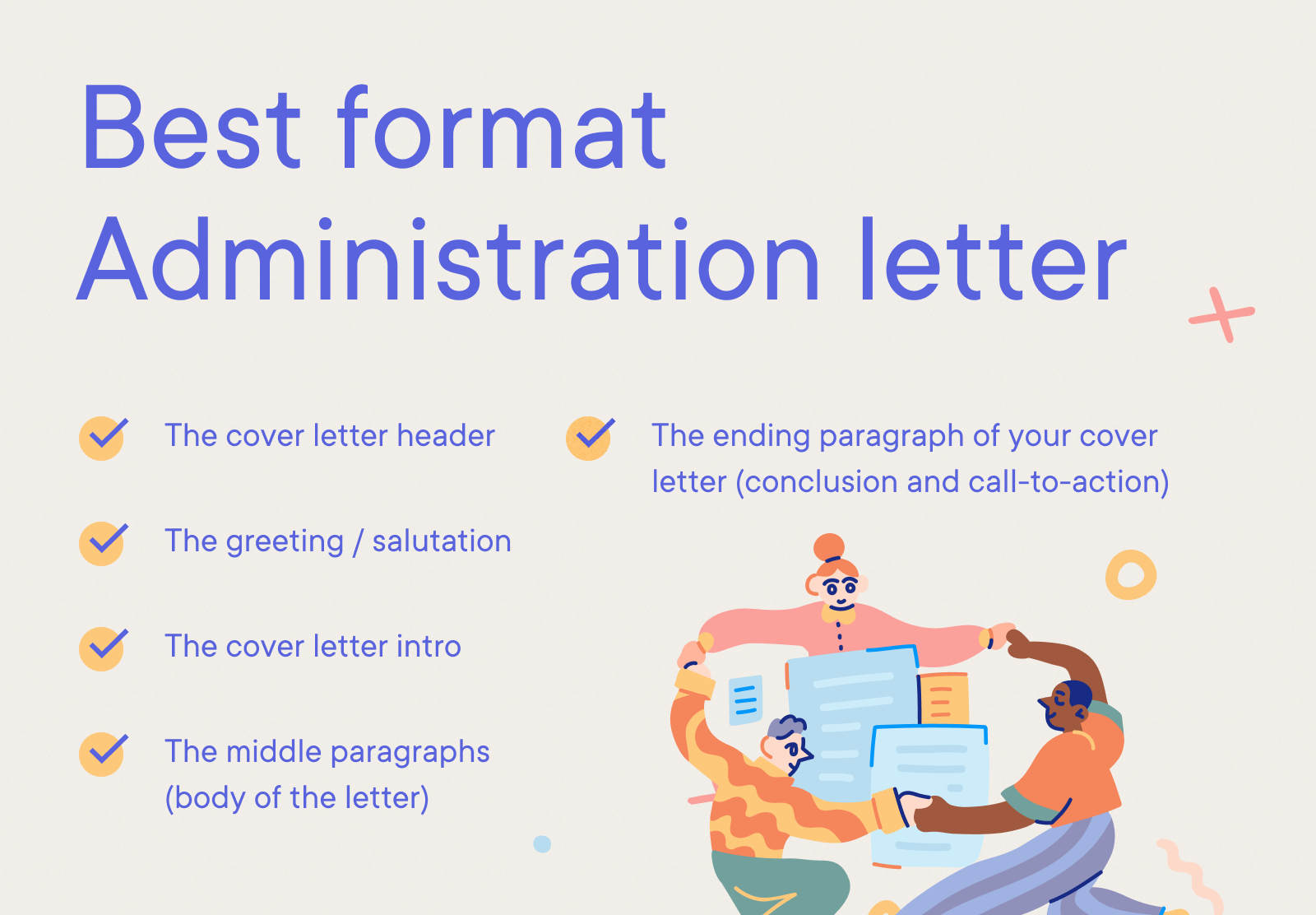
If you’re looking for additional inspiration for cover letter writing, you can check out our related administrative cover letter examples:
- Accounting cover letter sample
- Finance cover letter sample
- Banking cover letter sample
- Bookkeeper cover letter sample
- Finance Assistant cover letter sample
- Finance Manager cover letter sample
- Bank Teller cover letter sample
- Auditor cover letter sample
- Private Equity cover letter sample
- Accounting and finance cover letter sample
- Bank Manager cover letter sample
- Loan Processor cover letter sample
- Accounting Internship cover letter sample
- Financial Advisor cover letter sample
-
CFO cover letter sample
Best format for an administration cover letter example
Having a solid administration cover letter format helps you present an efficient and organized image. This means taking care of the formatting and structure of your letter.
The format of an administration cover letter should contain the following elements:
- The cover letter header
- The greeting / salutation
- The cover letter intro
- The middle paragraphs (body of the letter)
- The ending paragraph of your cover letter (conclusion and call-to-action)
The comprehensive cover letter guide offers more general advice about how to go about compiling cover letters, but below you will find specific advice on how to maximize the effectiveness of each specific letter paragraph and section.
This administration cover letter example is a good foundation to develop your own professional application:
Dear Mrs. Parker,
With 15 years of administration experience in hospitality and the past four running an outdoor leisure facility near Yellowstone, I understand the complexity of managing an efficient campsite. Given the intense seasonality and the pressure to maintain the highest standards of service when you are rushed off your feet, there is no administration job like it.
Every decision has an impact on the guests and every administrator needs to put them first – I increased repeat visits to my previous employer by 25% by tackling the four issues that matter most: top-notch facilities, well-trained staff, smooth communication and creating an organization that hums away quietly in the background (most of the time).
My nickname at my previous employer was “Mystic Molly.” I had an ability to see problems before they happened and ran a slot at the weekly meeting where people could “predict” potential issues in the week to come. It was a fun way of motivating the team to think proactively and I moved staff engagement metrics from a poor 69% to 92% over two years.
I understand that you intend to update your procurement procedures and introduce a glamping section. I hope that my following experience might prove useful:
- Managed a campsite with 150 pitches, 20 hard standings and 20 glamping pods.
- Saved 14% on a $900k operations budget by introducing centralised procurement.
- Raising cleaning and maintenance spend by 15% led to +35% glamping bookings.
My degree in hospitality and blue-chip training from the Blarriot Group during my early career have provided a solid foundation for making the best business decisions. I am a collaborative thinker and always seek to make the most of the “knowledge around the table.” You never truly understand the experiences of others until you involve them.
I am excited for the chance of an interview, and I already have a host of ideas to discuss with you. Adding glamping to your service offering creates certain operational challenges.
Your sincerely,
Theresa Bennett
Cover Letter Header
The cover letter header serves two main purposes. The first is to associate your document with you and make you memorable to recruiters. The header is the perfect place to include your name, phone number and even social media information in case a hiring manager wants to get in touch. In medium to large size companies, hiring is often handled by a team of people. Your header makes sure that no matter who comes across your application, they have all the necessary information.
The second purpose of your letter is to apply a bit of creative formatting to an otherwise bland sheet of paper. This might be one of the only places where you’ll be able to use color or other design elements, so it’s worth paying attention to the look of your header.
The goal of this section: Keep your name and contact details handy no matter who reads your letter, create an attractive presentation that’s associated with your name and makes you memorable.
Align document styles!
One of the best things you can do to create an exceptionally polished image, is to align the document styles of your cover letter and resume. This allows you to craft a “personal brand” – a look and feel that represents you throughout your application. If you have graphic design experience, you can try this out yourself. If not, online tools and templates like these from Resume.io can make the process much faster.
Before choosing a style, it’s a good idea to take a look at the website and materials of your prospective employer to see what sort of branding they use themselves. The goal is not to make a direct copy, but rather to capture their same level of formality and style.
Cover Letter Greeting
Your cover letter greeting may be short, but it’s one of the most vital sections when it comes to creating a personal connection and setting the right tone for the rest of the letter. If at all possible, address the hiring manager by name. “Dear” followed by the correct salutation and last name usually works well, but “Hi” or “Hello” and even a first name might be acceptable in less formal situations or if you submit the letter in the body of an email.
The goal of this section: Use the letter recipient's name to create a personal connection and get the letter off to a good start.
The importance of names and addressed greetings.
The evidence behind the importance of addressed greetings is not just anecdotal – science has actually shown that humans have a positive neurological response upon hearing their own name.
Unfortunately, in medium to large companies hiring is often taken care of by a sizable team. Even if you manage to find a few hiring managers’ or recruiter names online, it might be impossible to tell who will actually read your letter. In this case, you have a few options. “Dear Hiring Manager” may be acceptable or you can try “Dear (Company Name) Hiring Team.”
Cover Letter Introduction
The whole point of a great cover letter is to make your application stand out in a positive way. Nowhere is that goal more important than in your cover letter introduction. You’ll want to avoid a bland opening paragraph. Instead, opt for an exciting anecdote, relevant statistic or interesting fact as a way to catch a hiring manager’s attention and lead them into the body of your letter.
Notice that our cover letter example jumps right in with work history details, but also points to an understanding of an employer's pain point: "With 15 years of administration experience in hospitality and the past four running an outdoor leisure facility near Yellowstone, I understand the complexity of managing an efficient campsite."
The goal of this section: Hook the reader’s interest by using an anecdote, fact or statistic to create a noteworthy introduction.
Dear Mrs. Parker,
With 15 years of administration experience in hospitality and the past four running an outdoor leisure facility near Yellowstone, I understand the complexity of managing an efficient campsite. Given the intense seasonality and the pressure to maintain the highest standards of service when you are rushed off your feet, there is no administration job like it.
Cover Letter Body
The body section is where you can finally dive into all your most relevant accomplishments, as well as your relevant skills and experiences. Since this is the largest part of your letter, you can simplify the writing process by breaking it into two subsections.
In the first, you can try out the STAR method to briefly describe a Situation, the required Task, your Action and the ensuing positive Result. Choose examples that most closely mirror the tasks and skills you’ll encounter in the potential position.
In the second paragraph, you can make the best case for yourself as the company’s next employee by discussing your most relevant skills and potential contributions you could make.
Reread the second body paragraph of our cover letter sample: My nickname at my previous employer was “Mystic Molly.” I had an ability to see problems before they happened and ran a slot at the weekly meeting where people could “predict” potential issues in the week to come. It was a fun way of motivating the team to think proactively and I moved staff engagement metrics from a poor 69% to 92% over two years.
This example inserts a bit of personality while highlighting the value the candidate will bring.
The goal of this section: Highlight your strengths and advantages through the Star method and any potential contributions you could make.
Every decision has an impact on the guests and every administrator needs to put them first – I increased repeat visits to my previous employer by 25% by tackling the four issues that matter most: top-notch facilities, well-trained staff, smooth communication and creating an organization that hums away quietly in the background (most of the time).
My nickname at my previous employer was “Mystic Molly.” I had an ability to see problems before they happened and ran a slot at the weekly meeting where people could “predict” potential issues in the week to come. It was a fun way of motivating the team to think proactively and I moved staff engagement metrics from a poor 69% to 92% over two years.
I understand that you intend to update your procurement procedures and introduce a glamping section. I hope that my following experience might prove useful:
- Managed a campsite with 150 pitches, 20 hard standings and 20 glamping pods.
- Saved 14% on a $900k operations budget by introducing centralised procurement.
- Raising cleaning and maintenance spend by 15% led to +35% glamping bookings.
My degree in hospitality and blue-chip training from the Blarriot Group during my early career have provided a solid foundation for making the best business decisions. I am a collaborative thinker and always seek to make the most of the “knowledge around the table.” You never truly understand the experiences of others until you involve them.
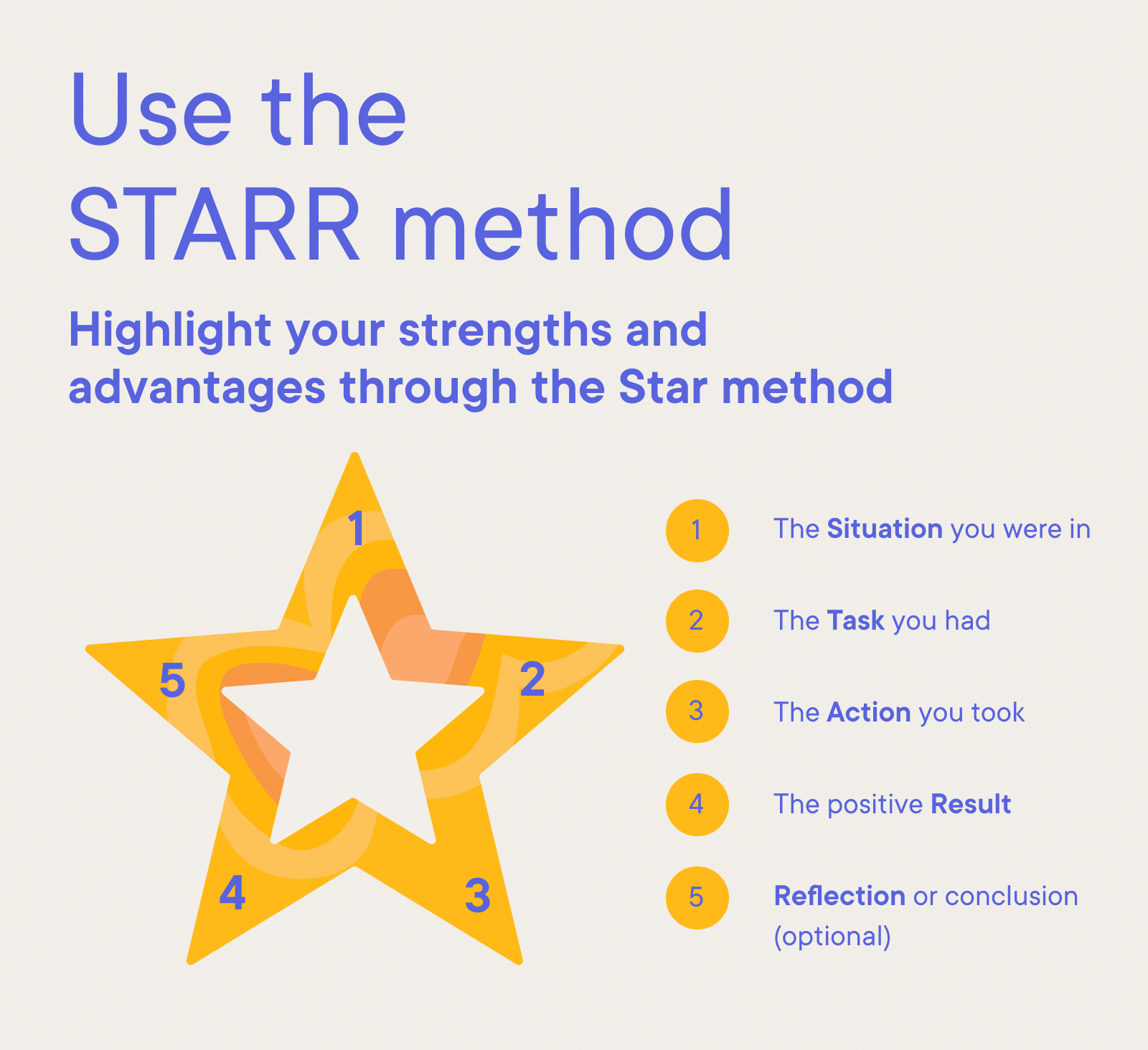
Cover Letter Conclusion and Signature / Sign-off
Now it’s time to wrap up your letter with the utmost professionalism and style. You can increase your chances of hearing from the hiring manager by creating an effective Call to Action. This sentence expresses your enthusiasm for the position and invites the reader to get in touch. You can also include your contact information again here, if you have the space to fit it all on one page.
Then, close out your letter with the appropriate signature. “Best regards,” “Sincerely” or even “Thank you for your consideration” can all be good options.
The goal of this section: Finish your letter with a respectful and enthusiastic Call to Action, then choose the most appropriate signature to end on a positive note.
I am excited for the chance of an interview, and I already have a host of ideas to discuss with you. Adding glamping to your service offering creates certain operational challenges.
Your sincerely,
Theresa Bennett
Writing psychology – cover letter tips and strategies
When working in administration, there are a few key qualities you’ll want your cover letter to convey:
- Organization: An administrative professional should have great attention to detail when it comes to organizing documents, schedules and events. Examples of your great organization skills can help an employer visualize your success at their company.
- Efficiency: An administrative assistant who works with speed and precision can greatly increase the outward perception of a company. Examples of times you got the job done under pressure can put you a step ahead of other candidates.
- Positive attitude: Many administrative roles have to handle clients, customers or patients. Even if you work within the company, a positive attitude and cheery disposition makes you a pleasure to work with and adds to the overall morale.
- Initiative: A great administrator anticipates what needs to be done and makes it happen without having to be reminded. Expressing your interest in the company or its activities shows how you will be motivated to take charge of your job duties.
Everyone loves a good story. Whether it’s a hilarious thing that happened to you way back when or a tale from a friend or relative, we can all remember a story that brings out emotion every time we think of it.
The evidence for the importance of stories is not just anecdotal. Neuroeconomist Paul Zak has spent years researching the power that a well-spun tale has on our brains – and more importantly our actions. A great story increases our sense of empathy and encourages us to cooperate with others, whether it be by giving them a hand or by buying a product.
Advertisers have long understood the ability of a great story to convince and persuade – just think of a memorable commercial.
You, too, can use this type of emotional hook to grab a hiring manager’s attention in your cover letter and make them more likely to view you as a top candidate.
While your “story” will come in the form of an experiential anecdote, probably from your education or another position, that doesn’t mean it can’t have some of the elements of a great story. A surprise, a success or a lesson learned can all make for great, concise anecdotes that show off your strengths.
The goal is not only to show the hiring manager or recruiter what you can do in the role, but also to make a personal connection and create a good impression of your personality.
It’s all in the details.
One of the most important things you can do to create a memorable cover letter is to get specific. Numbers, statistics, facts and other ways you can quantitatively measure your contributions to a company make your application stand out from other job seekers.
While you shouldn’t bog down your letter with too many unnecessary details, a few well-placed specifics can go a long way in proving your achievements and potential contributions to this new position.
Administration cover letter with no experience
Because administration is a great entry-level position, hiring managers are apt to get applications from job seekers who don't have direct experience. In these cases, they will be looking for general workplace skills, so you should be highlighting those in your cover letter.
If you have held part-time jobs or those unrelated to the work you seek now, consider the skills you learned that will make you a valuable employee. Many of these are soft, or interpersonal, skills.
Here are some areas to focus on and ways to include them:
- Communication: Have you worked in a group for school, in an extracurricular activity or as a volunteer? What communication skills did you use and how can you demonstrate them?
- Reliability: Do you take care of your responsibilities? Do you arrive on time?
- Organization: How do you juggle your schedule? How did you do it in school?
Make sure you explain in your cover letter why you want to enter this field. Instead of saying you are a fast learner, give an example of when you tackled a new task and how you got up to speed.
Administration cover letter format and common mistakes
As an administrative assistant or an employee in another administrative position, you’ll want to avoid these all-too-frequent cover letter pitfalls.
- Generic letters: Failing to research the company and its activities (a simple Google search often yields insightful results) is one of the biggest mistakes an administrative assistant candidate can make. While a copy-paste letter seems easy, hiring managers can easily spot the lack of effort and are likely to take offense. Make sure to tailor your letter to the exact type of work you’ll be doing at each of the companies you apply to. The job description can help with this and the recruiters will pay specific attention to whether you’ve analyzed it.
- Formatting mistakes: Poor formatting leaves a bad impression right from the start. If a hiring manager can’t clearly find your personal data or they get a headache from the unedited wall of text, they might give up trying to reach you for a job interview. Luckily, online formatting tools like Resume.io’s cover letter templates and online cover letter builder can help you create a professional cover letter in just a few clicks.
- Typos and spelling mistakes: Candidates for administrative assistant jobs need strong communication skills. Poor spelling and grammar give the impression you won’t be an effective communicator once inside the company. Make sure to use a cover letter builder with a spell check function (we’ve worked extra hard to make ours effective!) and/or have a friend proofread your letter before you submit.
- Focusing only on hard skills: All administrative positions need great soft (social) skills to do their jobs effectively. While you should make mention of relevant hard skills like Excel or Powerpoint, especially on your resume, your cover letter is a great place to expound on the personality traits that make you stand out.
Key takeaways
- Unless an application specifically asks you NOT to include a cover letter, it’s always a smart idea to include one and increase your chances of landing the position. Remember that the resume and cover letter are a powerful duo - each covers the other’s gaps or flaws. Worried that the resume leaves some lingering questions about you? The cover letter is your chance to put those to rest and surpass the competition.
- Tailoring your cover letter to each company and position makes your application stand out by showing a recruiter you’re an attentive and invested candidate.
- Follow the tried-and-true structure to simplify the cover letter writing process and keep your letter interesting and concise. Resume.io’s pre-generated content will help you with that.
- Use interesting anecdotes with specific details that illustrate your successes to make your letter memorable even for positions where competition is high.
- Sloppy formatting can make your application look unprofessional. Resume.io’s cover letter templates simplify the process so you can apply with confidence every time.


